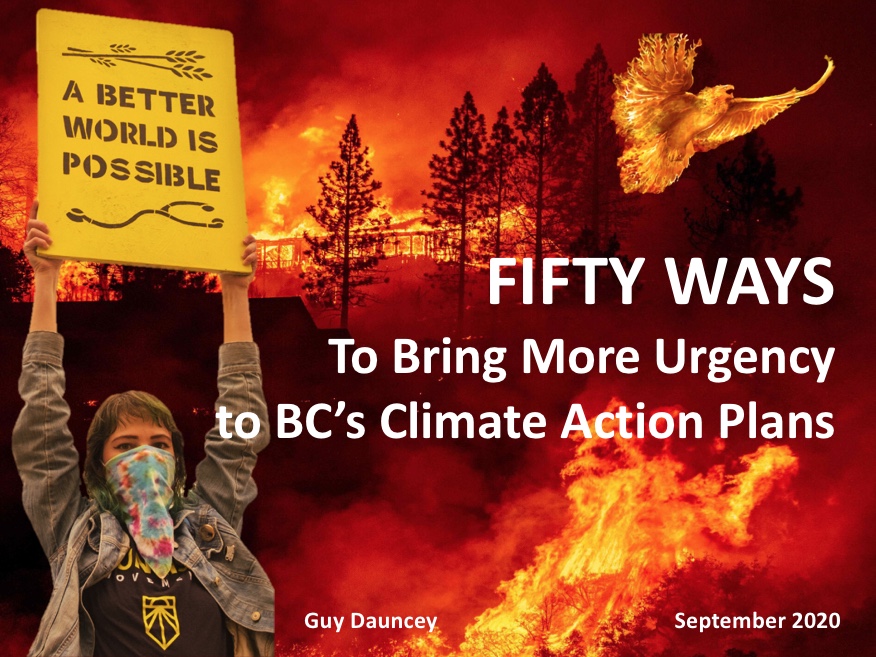Download a printable version of Fifty Ways to Bring More Urgency to BC’s Climate Action Plans
“We are facing a disaster of unspoken suffering for enormous amounts of people, so please, treat the climate crisis like the acute crisis it is, and give us a future.”
– Greta Thunberg
Foreword
As I write this paper, terrible forest fires are raging in Washington, Oregon and California, and most people who are not entrenched climate deniers are either thinking or feeling that
“This climate crisis is frighteningly real. We really need to act with more urgency.”
In June 2020, thousands of citizens, activists and climate scientists sent an open letter to European and global leaders. After making various proposals similar to those in this paper, they wrote:
We understand and know very well that the world is complicated and that what we are asking for may not be easy.The changes necessary to safeguard humanity may seem very unrealistic.
But it is much more unrealistic to believe that our society would be able to survive the global heating we’re heading for, as well as other disastrous ecological consequences of today’s business as usual.
To limit global heating to 1.5 degrees, the upcoming months and years are crucial. The clock is ticking. Doing your best is no longer good enough. You must now do the seemingly impossible.
Even though you might have the option of ignoring the climate crisis, that is not an option for us – for your children.
Right now, there is no place on Earth where children face a future in a safe environment. This is and will be very much a reality for the rest of our lives.
We ask you to face the climate emergency.

| Author Guy Dauncey | September 2020 | ISBN 978-0-9738058-4-0 |
Creative Commons Attribution 4.0 International License.
You are free to copy and redistribute as long as you give credit to the author and link to the website
www.thepracticalutopian.ca
TABLE OF CONTENTS (click the section you want to see)
Goals and Leadership
- Ring the Climate Alarm Bells
The Parallel Biodiversity Emergency
- Increase the Ambition of BC’s Climate Goals
- Show More Urgent Leadership
The Challenge is Huge
The Key to Success
What Does the Public Think?
- Inspire Widespread Public Mobilization
- Recruit 250,000 Climate Leaders
- Recruit 5,000 Youth Climate Rangers
- Inspire Widespread Public Education
- Teach Ecology 101 and Climate Solutions in All Schools
- Help Local Governments to Tackle the Crisis
Economic and Financial
- Establish a Green Development Bank of BC
- Increase the Carbon Tax
- Require Green Finance
- Change Economic Modelling
Business and Industry
Fossil Fuel Extraction and Exports
- Continue to Oppose the TransMountain Pipeline
- End Coal-Mining by 2025
- End the Export of Coal from Roberts Bank
- Withdraw All Government Support for Liquefied Natural Gas
- End the Extraction of Natural Gas by 2040
- End the Extraction of Oil in BC by 2040
Jobs
Forestry
Transportation
- Accelerate BC’s Commitment to Active Transportation
- Accelerate the Transition to Electric Buses
- Advance the Electric Vehicles Mandate from 2040 to 2025
- Change the ZEV Incentive to a Vehicle Feebate
- Accelerate the Transition to Electric Heavy Duty Trucks
- Accelerate the Transition to Electric Ferries, Boats and Ships
- Accelerate the Transition to Electric Aviation
- Raise the Low Carbon Fuel Standard
Electricity
- Accelerate the Transition to Renewable Energy in Off-Grid Communities
- Accelerate Initiatives to Help Indigenous Communities End Climate Pollution
Buildings
- Require All New Buildings to Produce Zero Climate Pollution by 2022
- Require Building Energy Labelling
- Develop a Province-Wide Strategy for Mass Retrofits
- Establish a New Crown Corporation: Retrofit BC
- Develop New Retrofit Financing Mechanisms
- Enact New Retrofit Legislation
- Recruit 5,000 Youth Retrofit Rangers
Agriculture
- Incentivize Carbon Storage in the Soil
- Plan a Full Transition to Regenerative Organic Farming
- Reduce Farm Methane Emissions
- Encourage all Farms to Embrace 100% Renewable Energy
Carbon Sequestration
Impacts, Adaptation and Restoration
- Require Climate Impact Scorecards and Sustainable Procurement
- Combine Climate Adaptation with Ecological Restoration
- Recruit 5,000 Youth Restoration Rangers
Appendix: Summary of Estimated Costs
About the Author
See reactions to Feedback Fifty Ways
“For years, Guy Dauncey has tirelessly warned of the urgency of tackling the climate crisis and provided practical ways to achieve reductions in our emissions. While the crisis has only worsened, the window of opportunity to shift direction has shortened. Here is a blueprint for concrete action. Read it and act!”
- David Suzuki
“An inspired paper.
Guy Dauncey is always a source of practical yet visionary ideas.
Here he shows why BC’s climate plan needs a reboot,
and what a true provincial climate emergency plan can look like.”
- Seth KleinAuthor of A Good War: Mobilizing Canada for the Climate Emergency
“We need to put the climate emergency on a war-time footing, with unparalleled investments into transitioning away from fossil fuels. I hope candidates from all parties in the 2020 BC election take the time to read and champion these ideas. We have no time to lose.”
- Coro Strandberg, Sustainability Strategist
“Guy Dauncey is a prolific writer and a pragmatic optimist. This is a simple, no-nonsense recipe for action to address the climate crisis.”
- Ted SheldonRetired, BC Government Senior Community Climate Action Advisor
SUMMARY
Nowhere in the BC NDP government’s climate action plans is there any sense of urgency or alarm – and yet history tells us that most people only get up off their couches to engage for change when they feel obliged to do so by pain, compassion, shock or alarm.
The climate emergency is appallingly real. The Canadian public is ready, waiting for the politicians to catch up.
- 81% of Canadians feel that the climate emergency poses a major threat to the future of their children and grandchildren;
- 86% believe that Canada has the potential to be among the world’s most successful countries in developing clean energy technologies;
- 79% would be even more supportive of bold climate action if their governments provided financial support to low-income families to help them transition away from fossil fuels.
Where is our climate Churchill, who will end the long years of climate appeasement and convey the true urgency that the crisis calls for?
What would a real Climate Emergency Plan look like? BC has just entered a provincial election, offering a major opportunity for the consideration of important new ideas.
Yes, we are in the midst of a pandemic. But to suggest that this makes it an inappropriate time to focus attention on the climate crisis is like saying that we should ignore the reality that our house is on fire, because someone inside the house has Covid-19. We are adults. We can pay attention to and tackle the many crises that face us at the same time.
Fifty Ways offers many possibilities, premised on the reality of the climate emergency and a positive vision of life beyond fossil fuels. The author, Guy Dauncey, has written two major books on climate solutions. He is founder of the BC Sustainable Energy Association, and the author of Climate Emergency: A 26-Week Transition Program for Canada (January 2020), on which he was invited to speak to MPs in Ottawa before Covid-19 struck. He is President of the Yellow Point Ecological Society, and a member of the GTEC Council for the New Green Economy. He lives near Ladysmith, BC.
The proposals that Dauncey is laying on the table for BC’s next government include the following initiatives:
- Establish a separate Ministry for Climate Emergency Action, and a Cabinet Climate Emergency Committee chaired by the Premier.
- Advance BC’s goals to a 65% reduction below 2007 by 2030, 80% by 2035, and 100% by 2040.
- Develop a Climate Mobilization Strategy to reach all five million British Columbians in person.
- Recruit 250,000 Climate Leaders who will commit to zero-carbon transportation and heating by 2022.
- Recruit 5,000 Youth Climate Rangers who will volunteer for two years of service, with pay similar to CERB, followed by free college education or training.
- Require all schools to teach all students Ecology 101 and Climate Solutions.
- Establish a public Green Development Bank, similar to those in Europe.
- Increase the carbon tax by $20 a year, reaching $240 per tonne by 2030, and mail a Climate Action Dividend cheque to every low and middle-income household every January.
- Establish 13 Clean Economy Climate Partnerships. Ask each to research and lay out how it could end climate pollution in its sector of the economy by 2040.
- Tell every business in BC that it is expected to achieve zero climate pollution by 2040.
- Offer zero-interest loans to help businesses achieve the goal.
- Establish a Circular Economy Crown Corporation to achieve a fully circular BC economy by 2050.
- End all coal mining by 2025.
- End all oil and natural gas extraction by 2040.
- Withdraw all government support from liquefied natural gas (LNG).
- Create a Good Jobs Guarantee to protect all affected workers, with a clear pathway to new jobs.
- Develop a Climate-Compliant Forest Management Strategy.
- Accelerate BC’s Active Transportation goal to 10% of personal trips by 2030, 25% by 2040.
- Advance the Zero Emissions Vehicle Mandate date to 2025, but make it flexible.
- Accelerate the transition to electric buses, trucks, ferries, boats, and planes.
- Accelerate initiatives to help BC’s Indigenous communities end climate pollution.
- Require every new building to be built to the Passive House Standard by 2022.
- Establish RetrofitBC as a Crown Corporation to deliver mass, deep neighbourhood-scale retrofits.
- Recruit 5,000 Youth Retrofit Rangers, similar to the Climate Rangers.
- Develop a system of Soil Carbon Certification, and use it to increase farmland soil carbon.
- Establish a Regenerative Farmland Transition Council to achieve a transition to regenerative farming and holistic ranch land management by 2040.
- Set a provincial goal for carbon sequestration and storage.
- Require Climate Impact Scorecards and a Sustainable Procurement Duty for all government contracts.
- Prepare new flood maps for all coastal communities, assuming a 2.5 metres rise in sea-level by 2100.
- Recruit 5,000 Youth Restoration Rangers, similar to the Climate Rangers.
We also need to understand that it is not climate pollution as such that is causing the climate emergency: it is our accumulated climate pollution.
We therefore face not one climate challenge, but two:
Challenge #1: To reduce our annual climate pollution to zero.
Challenge #2: To draw the surplus atmospheric carbon down to its preindustrial level, from 900 Gt to 600 Gt.
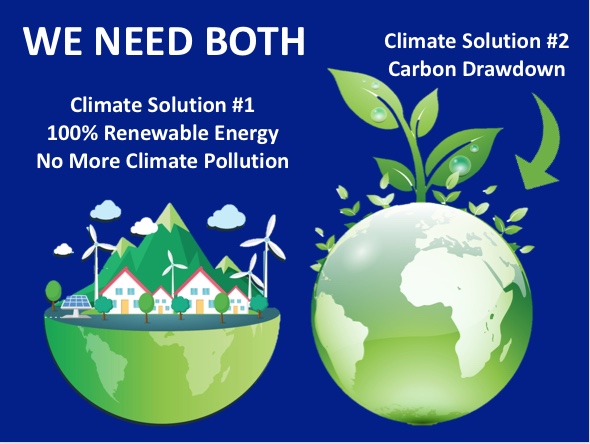
| Guy Dauncey | 250-924-1445 | guydauncey@earthfuture.com |
Goals and leadership
In December 2018 I watched with anticipation as the BC government launched its Climate Action Plan, ‘CleanBC’, laying out how BC could get 75% of the way towards achieving a 40% reduction in BC’s climate pollution by 2030, 80% by 2050. StrongerBC, launched in September 2020, includes additional initiatives to tackle the climate crisis.
The CleanBC plan was praised by many people, and yet I was and remain troubled. I am now laying out my concerns in a constructive form. My hope is that these fifty suggested improvements will launch a conversation, opening a window for many of the ideas to be debated and hopefully implemented.
1. Ring the Climate Alarm Bells
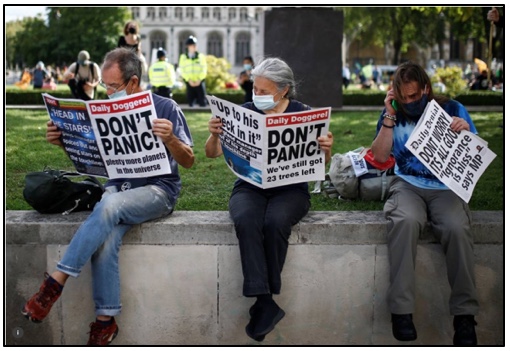 Nowhere in the BC government’s climate action plans, CleanBC, or in subsequent announcements, is there any sense of urgency or alarm. The government has seemingly been guided by climate psychologists who have recommended that they play it down, and advise their MLAs and staff at the Climate Action Secretariat not to make people upset by sharing the alarming evidence of a looming climate catastrophe if we fail to end our climate pollution.
Nowhere in the BC government’s climate action plans, CleanBC, or in subsequent announcements, is there any sense of urgency or alarm. The government has seemingly been guided by climate psychologists who have recommended that they play it down, and advise their MLAs and staff at the Climate Action Secretariat not to make people upset by sharing the alarming evidence of a looming climate catastrophe if we fail to end our climate pollution.
I understand the concern, but the climate turn-off happens if you ONLY talk danger. I have been giving climate talks for 25 years, and I know from experience that what works best is ten minutes of hard climate truths followed by fifty minutes of visionary solutions and urgent leadership. Comfort is comforting. People love it – and that’s the core of the problem. History tell us that most people only get up off their couches to engage for change politically when they feel obliged to do so by pain, compassion, shock or alarm.
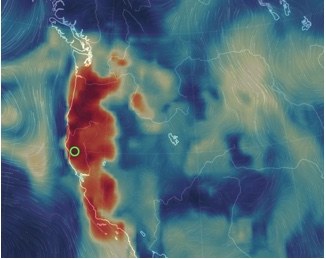 The climate emergency is appallingly real. BC has already been devastated by the Mountain Pine beetle, and more recently by increasingly destructive floods, by increasingly intense forest fires with all the associated air pollution, by crop failures due to forest fire smoke, by heat exhaustion among poultry and livestock, by failed salmon spawning and migration due to increased ocean and river temperatures, by torrential rain landslides and middle-of-the-night evacuations as in in Kaslo and Johnson’s Landing, and by melting glaciers on Vancouver Island, all along the Coast Mountains range, in the Cariboo, and in the Rockies, threatening fresh water supplies.
The climate emergency is appallingly real. BC has already been devastated by the Mountain Pine beetle, and more recently by increasingly destructive floods, by increasingly intense forest fires with all the associated air pollution, by crop failures due to forest fire smoke, by heat exhaustion among poultry and livestock, by failed salmon spawning and migration due to increased ocean and river temperatures, by torrential rain landslides and middle-of-the-night evacuations as in in Kaslo and Johnson’s Landing, and by melting glaciers on Vancouver Island, all along the Coast Mountains range, in the Cariboo, and in the Rockies, threatening fresh water supplies.
California has entered an era of megafires. Hundreds of regional blazes have burnt more than four million acres of land since mid-August, burning entire small towns and turning parts of California into a red-orange hellscape. 40,000 people in Oregon have been forced to flee their homes. Several small towns have been destroyed.
From fire to water: the world’s oceans are absorbing 90% of the increased atmospheric heat, causing more intense storms and hurricanes. The world’s climate science community is warning us that our world is on track for a 3-4°C increase in temperature by 2100. And heed this: the last time the world was 3 degrees warmer, the sea-level was 25 metres higher, sufficient to inundate vast areas of Vancouver and the Lower Mainland. That won’t happen until the next century, but once underway, these huge global climatic processes can’t be easily undone, if at all.
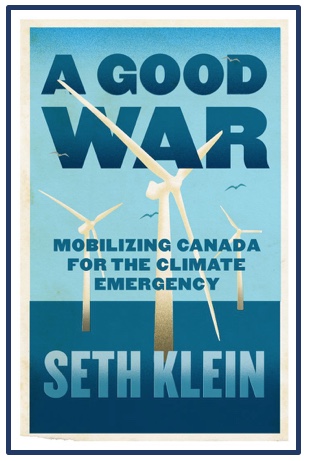 Greta Thunberg is right when she said, “We are facing a disaster of unspoken sufferings for enormous amounts of people; so please, treat the climate crisis like the acute crisis it is, and give us a future. Our lives are in your hands,” and “The one thing that’s worse than not doing enough is to pretend that you’re doing enough.”
Greta Thunberg is right when she said, “We are facing a disaster of unspoken sufferings for enormous amounts of people; so please, treat the climate crisis like the acute crisis it is, and give us a future. Our lives are in your hands,” and “The one thing that’s worse than not doing enough is to pretend that you’re doing enough.”
I share Seth Klein’s alarm when he writes in A Good War: Mobilizing Canada for the Climate Emergency that regarding both federal and provincial climate plans,
“The level of ambition is nowhere near where we need it to be. These plans are painfully slow. They do not reflect or communicate a sense of urgency.”
The recently published 2018 data show that BC’s climate pollution is rising, not falling. In a predictable response, the BC Business Council is arguing that BC’s climate ambitions should be scaled back, rather than increased.
The Collapse of Biodiversity
The climate crisis is intimately connected to the ecological and biodiversity crisis. In its Living Planet Report 2020 the WWF reported that global wildlife populations are in freefall, due mainly to intensive chemical agriculture and the destruction of habitat such as forests to produce food. Between 1970 and 2016 there has been:
- A 68% decline in global vertebrate species populations — mammals, birds, amphibians, reptiles and fish.
- An 84% decline in wildlife populations found in freshwater habitats.
- A 59% decline in Canadian species at risk.
- A 9% a year decline in land-based insects, including the all-important pollinators.
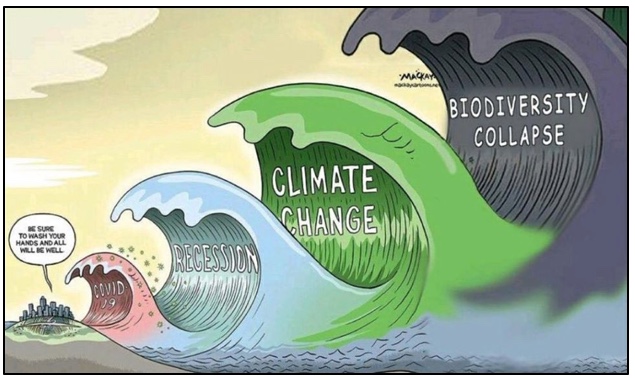 Action: Don’t play it down. Tell people the unvarnished truth about the climate danger and the biodiversity emergency. No-one would have bothered to join Canada’s army, navy or air force in 1940 if they had not been motivated by the reality of the Nazi threat, as well as by the vision of victory, creating the public determination needed to restore peace and freedom.
Action: Don’t play it down. Tell people the unvarnished truth about the climate danger and the biodiversity emergency. No-one would have bothered to join Canada’s army, navy or air force in 1940 if they had not been motivated by the reality of the Nazi threat, as well as by the vision of victory, creating the public determination needed to restore peace and freedom.
Action: Use appropriate language. The editorial staff at the Guardian newspaper have made a language-change commitment, using the expression ‘climate emergency’ or ‘climate crisis’ instead of ‘climate change’, and ‘climate science denier’ or ‘climate denier’ instead of ‘climate sceptic’. Throughout this paper I use the expression ‘climate pollution’ rather than ‘GHGs’ or ‘emissions’.
Yes, we are in the midst of a pandemic. But to suggest that the demands of the pandemic make it inappropriate to focus attention on the climate crisis is like suggesting that someone should ignore the reality that their house is on fire because someone inside the house has Covid-19. We are adults. We can pay attention to and tackle the many crises that face us at the same time.
2. Increase the Ambition of BC’s Climate Goals
The IPCC climate scientists tell us that to keep any possibility of limiting global warming to 1.5 degrees, our global climate pollution needs to fall by 55% by 2030. The world’s developing nations face a much larger struggle to reduce their emissions, so a prosperous province like BC, where most of our electricity is already 100% renewable, should aim for more, taking the lead at the front of the pack. The Berlin-based Carbon Disclosure Project Europe says that to put Europe’s 2030 target in line with the latest climate science and limit the warming to 1.5°C would either call for a 60-65% decrease by 2030, or much more rapid reductions after 2030. The global organization Architecture 2030 says that to keep within our remaining carbon budget we must reduce emissions by 50% to 65% by 2030, and completely phase out fossil fuel CO2 emissions by 2040. The Exponential Roadmap, published in September 2020 by Future Earth, WWF, Potsdam Institute for Climate Impact Research, Stockholm Resilience Centre and others calls for global climate pollution to be halved by 2030.
BC’s current goals, for a 40% reduction by 2030 and 80% by 2050, are not up to task. They need recalibration to reach the targets that the climate science calls for.
- Denmark has passed a binding law to cut it climate pollution by 70% by 2030.
- Finland has set a goal to be 100% carbon neutral by 2035.
- Holland is aiming at a 49% reduction by 2030, 95% by 2050.
- Germany is targeting a goal of 55% below 1990 by 2030.
- The European Union is proposing to upgrade its goal to 55% below 1990 by 2030.
Action: Advance BC’s goals to a 65% reduction below 2007 by 2030, 80% by 2035, 100% by 2040.

3. Show More Urgent Leadership
The staff in BC’s Climate Action Secretariat have been working very diligently, but on a policy foundation that will likely be unable to achieve even the current inadequate goals. Where is our climate Churchill, who will end the long years of climate appeasement and convey the true urgency that this crisis calls for?
Action: Establish a Ministry for Climate Emergency Action, separate from the Ministry of Environment, which has its hands full with a thousand other demands.
Action: Establish a Cabinet Climate Emergency Committee, to meet monthly chaired by the Premier, advised by the new Climate Solutions Council.
Action: Establish a Youth Climate Solutions Council, to give a voice to our younger people.
Action: Pass legislation requiring proportionality and transparency in lobbying, to ensure that fossil fuel companies do not use their huge financial fire-power to inundate government staff with go-slow arguments, without an equal opportunity being provided to people from social, environmental and First Nations communities, most of which cannot afford to hire professional lobbyists.
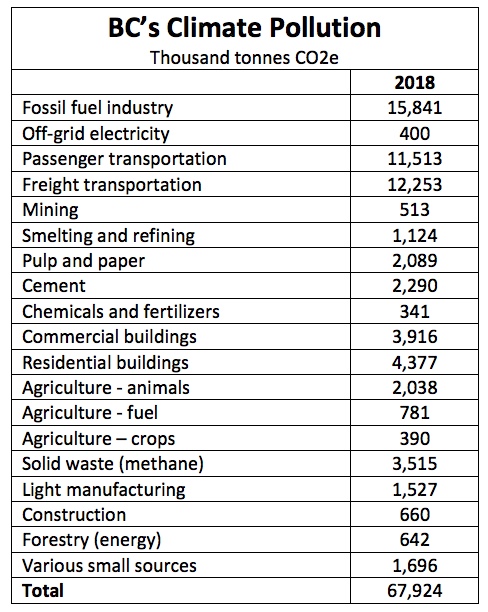
The Challenge is Huge
Time looking at these numbers with a pocket calculator reveals that:
- If we end all extraction of coal, oil and gas by 2040, we will achieve a 23% reduction in BC’s emissions.
- If every heavy duty truck becomes electric: 18%
- If everyone adopts electric transportation: 17%
- If all heavy industry switches to 100% renewable energy: 9%
- If everyone switches from oil and gas residential heat to a heat pump: 6%
- If all organic waste is diverted from landfills and all landfill methane is captured (which is technically not yet possible): 5%
- If everyone eats a vegan diet: 3%
- If all light manufacturing uses 100% renewable energy: 2%
Globally, the livestock industry produces 14.5% of the world’s climate pollution; all the imported meat and dairy that we buy carries some of this responsibility. In BC, agriculture produces 4.7% of our climate pollution. Meat and dairy produce 3%. This only tells half the story, however, since conventional farming practices are also the prime reason for the collapse of nature and biodiversity.
We need to understand that it is not our climate pollution as such that is causing the climate emergency: it is our accumulatedclimate pollution. We therefore face not one climate challenge, but two:
Challenge #1: To reduce our annual climate pollution to zero.
Challenge #2: To reduce atmospheric carbon to its pre-industrial level, from 900 Gt to 600 Gt.
Farming and forestry have a huge role to play here, since changed management practices could increase carbon sequestration in BC’s forests, farmlands and ranchland soils.
A 65% reduction in our climate pollution by 2030 will require a 7% annual reduction. To achieve 100% reduction by 2040, we will need to:
- Phase out all use of fossil fuels.
- End all extraction and exports of coal, oil and gas.
- Convert all building heat to electric heat pumps, biogas, or renewable energy district heat.
- Construct all new buildings to the Passive House standard, requiring no external heat at all.
- Convert all vehicles large and small to run on electric power.
- Convert all ships, ferries, boats and trains to run on electric power.
- Convert all flights to run on electric power or clean hydrogen sourced from renewable energy, not natural gas.
- Convert all industrial equipment to run on electric power, including heavy-duty mining equipment.
- Continue to produce our electricity from renewable sources, assuming hydro-power to be carbon neutral.
- Convert every manufacturing and industrial operation to clean hydrogen for intense heat.
- Eliminate the powerful greenhouse gases N2O, HFCs and PFCs from all industry and manufacturing.
- Reduce the climate pollution from animal methane and manure as much as is biologically possible.
- Send zero organic waste to landfills, and capture all the methane that escapes from our landfills.
None of this includes the embodied carbon pollution that we import with the consumer products we buy, many of which are made in China using coal-fired power, and are shipped to BC using dirty bunker oil.
The Key to Success – A Strong Positive Vision
In the 1890s, the city streets of Europe and America were full of horses. By 1920 they were full of cars. Our great grandparents achieved a transition similar that needed today. We can do it again. It is mostly about our use of energy, almost all of which comes from the Sun:

- Heat and light from the Sun take 8 minutes to reach the Earth. Every year, the Sun provides 10,000 times more energy than we use.
- For 300 million years, our ancestors accepted the Sun’s energy as it was.
- 300,000 years ago, they learnt how to use the Sun’s heat by burning firewood.
- 300 years ago, they learnt how to use the Sun’s heat by burning fossil fuels.
- 30 years ago, we began using the Sun’s heat directly, thanks to efficient PV panels.
- The Sun will continue sending its energy to Earth for another 3 billion years.
- With every passing year, the efficiency of solar and other renewable energy technologies will increase, and their cost will fall. It is an astonishing reality, with huge implications for the future of our civilization.

Fossil fuels gave our civilization an invaluable burst of ancient solar energy, that enabled our ancestors to break out of medieval feudalism and develop science, technology and modern medicine. Fossil fuels were an essential booster rocket. They launched us into the Solar Age, but their work is now done. We need show gratitude, let them go, and embrace the future. So many more new jobs will be created in the transition than will be lost. We need to embrace the transition whole-heartedly, and not be swayed by the arguments of current and retired fossil fuel executives who seek continued domination of both energy markets and politics by casting doubt on the climate science at the expense of our children’s future.
This is not a question of optimism versus pessimism. That is for observers, who are content to watch the play of events from the stands. The question for players is whether we are determined or defeated.
What Does the Public Think?
Some politicians believe that they can’t let climate policy ‘get ahead of the public’. The public is already there, however, waiting for them to catch up. In July 2019, in preparation for his book A Good War, Seth Klein commissioned an extensive national poll of 2,000 Canadians from Abacus Data. The results showed that:
- 82% of Canadians rate climate change as an extremely serious or serious problem.
- 42% believe it is already an emergency; a further 20% believe that it will be within the next few years.
- 81% feel that the climate emergency poses a major threat to the future of their children and grandchildren.
- 58% responded positively to the proposal that the climate emergency should require governments to adopt a war-time response, making major investments to retool our economy and mobilizing everyone to transition off fossil fuels and into renewable energy. 65% of young people supported this proposal.
Support is already there for forward-looking climate policies:
- 62% support or strongly support transitioning all government vehicles to electric by 2025; a further 22% can accept this.
- 55% support requiring all new buildings to use electricity and heat pumps for heat by 2022 instead of oil or gas; a further 23% can accept this.
- 50% support phasing out the extraction and export of fossil fuels over the next 20 to 30 years; a further 24% can accept this.
- 42% support banning the sale of new gas-powered cars, vans and light trucks by 2030; a further 25% can accept this.
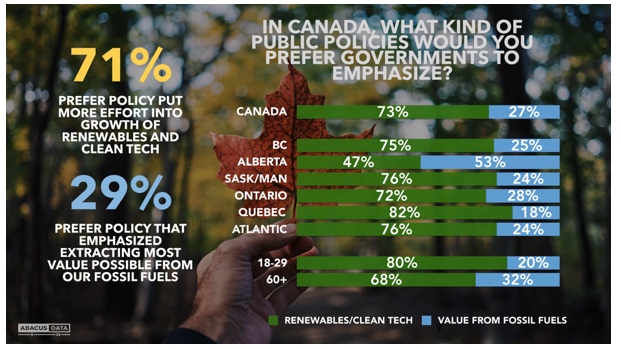
Public support for bold climate action grows stronger if these policies are also in place:
- 79% are more supportive if governments provide financial support to low-income families to help them transition away from fossil fuels.
- 78% are more supportive if income taxes do not increase as a result of the plan.
- 78% are more supportive if the wealthy and large corporations are required to pay more taxes to help pay for the plan.
- 77% are more supportive if low and modest income families receive a climate action dividend to help offset rising costs.
- 73% are more supportive if the government is committed to a ‘good jobs guarantee’ for all people working in fossil fuel industries.
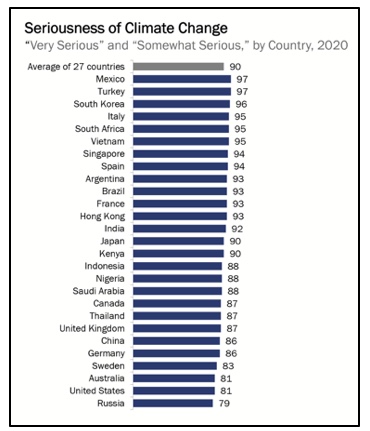 In 2019 Clean Energy Canada commissioned a similar countrywide Abacus poll for their report The Fast Lane:
In 2019 Clean Energy Canada commissioned a similar countrywide Abacus poll for their report The Fast Lane:
- 6% believe that “Canada has the potential to be among the world’s most successful countries in developing and using clean energy technologies.”
- 73% want Canada to support the growth of our renewable energy and clean technology sectors.
- 73% say “Success in developing and using clean energy technologies can create as many new jobs as those which would be lost in oil and gas”.
A September 2020 Abacus Poll found that public support for climate action has grown even stronger:
- 91% of Canadians cite climate change as a serious issue.
- 88% report that climate change has impacted them.
- 85% believe that the government should invest in clean technology.
A Globe Scan September 2020 poll found a growing climate alarm throughout the world, averaging 90% of people who thought the crisis was either very or somewhat serious.
Education and mobilization
4. Inspire Widespread Public Mobilization
To act with the urgency required we need widespread citizen engagement in our homes, businesses, clubs and places of worship. In Britain during World War II victory would not have been possible without the millions of people who volunteered to join the Red Cross, the YMCA, the Women’s Voluntary Service, the St John Ambulance Brigade, Oxfam, and the Home Guard, which by June 1940 had 1.5 million volunteers.
Action: Develop a province-wide Climate Mobilization Strategy designed to reach all five million British Columbians in person over the next five years. Form a single motivating organisation: let’s call it Climate Action BC. Divide BC into 10 regions of 500,000 people with ten Climate Hubs in each region, each supporting 50,000 people. Fund a 3-person team to manage each Climate Hub, supporting Climate Leaders and Youth Climate Rangers (see below). Give Climate Action BC a staff of 10 and each Climate Hub a staff of 3, for 310 people. If each was paid $50k that would cost $16 million a year, including office costs.
5. Recruit 250,000 Climate Leaders
Action: Put out a public call for 250,000 Climate Leaders (5% of BC’s population) who will make the commitment to zero-carbon transportation and zero-carbon heating within two years. This would be 2,500 people or 1,600 households in each Climate Hub, each supported by a trained Youth Climate Ranger (see below).
Action: Offer a Community Climate Action Prize of $50,000 to the first five small communities people to persuade 25% of their residents to make the commitment to become 100% zero carbon in transportation and heat by 2025. In this way we can learn which climate conversations work best, before moving to province-wide adoption.
6. Recruit 5,000 Climate Rangers
The pandemic is playing hell with young people’s lives, at a time when many already feel alarmed about the climate and ecological crises, and worried about finding a job and an affordable home.
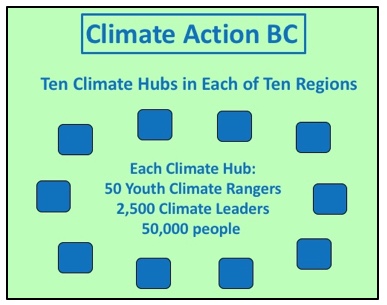 Action: Address both needs by recruiting 5,000 Climate Rangers – young people who would volunteer for two years of service, with pay similar to the Canada Emergency Response Benefit (CERB), at the end of which they would be offered free college education or training.
Action: Address both needs by recruiting 5,000 Climate Rangers – young people who would volunteer for two years of service, with pay similar to the Canada Emergency Response Benefit (CERB), at the end of which they would be offered free college education or training.
- Each Climate Hub supports 50 Climate Rangers.
- Each Climate Ranger supports 50 Climate Leaders, meeting with them in person to share information about public transit, electric vehicle costs, car-share clubs, electric bikes, home retrofit and heat-pump subsidies, and low-meat dietary options.
- Each Climate Ranger also supports 2,000 people, meeting 400 people a year in 160 households, with the goal of reaching everyone by 2025.
- If each Climate Ranger is paid $24k a year, this would cost $120 million a year.
7. Inspire Widespread Public Education
Action: Develop a public education initiative that will ring the warning bells, show the vision of a clean energy future, display an inspiring array of climate solutions, and show how people can tackle the emergency.
Action: Work with a non-profit partner to develop a digital Climate Crisis exhibit that any community can download and display in a local hall, as the British Natural History Museum does with its annual Wildlife Photography Awards, recently displayed at the Royal BC Museum.
Action: Establish an Annual Climate Action Day when awards are given out in a big celebration with musicians, poets and artists. Late November would suit, just before the annual UN global climate conference.
Action: Develop motivational public advertising, sharing information about the crisis and its solutions, inviting people to become Climate Leaders and Climate Rangers.
Action: Phase in a ban on advertising for gas stations and gas-powered cars and trucks, or place a tax on such advertising and use the revenue to pay for advertisements for electric vehicles, cycling and public transit.
8. Teach Ecology 101 and Climate Solutions in All Schools
The climate and ecological emergencies are warning us that we cannot afford to be so ecologically ignorant as a society. We pay so little attention to Nature in school, enabling children to graduate and go on to become economists, politicians and CEOs without understanding how the carbon cycle works, why agricultural chemicals harm the soil, why it is not a good idea to fill our bodies with toxic chemicals, or why keystone species such as the wolves, sharks, starfish, sea otters, krill, grizzly bears and pollinators are so essential to the integrity of their ecosystems.
Many schools offer classes on the climate crisis, but most teachers focus only on the dangers, not the solutions, causing children to become alarmed without any corresponding hope.
Action: Require all schools to teach Ecology 101 and Climate Solutions to all students, starting in Fall 2022. This will allow two years to create the curriculum and train the teachers.
9. Help Local Governments to Tackle the Crisis
The Capital Regional District has a steadily growing population, most of whom drive cars. It also has an active set of climate policies and programs, and a goal to reduce its climate pollution by 33% below 2007 by 2020. In 2020, it received the data on its climate progress up to 2018. Its population had grown by 15% and its emissions per person had declined by 14%, yielding a climate pollution reduction of just 1.1%.
Most local governments in BC want to show climate leadership, but they can’t provide subsidies for EVs or home retrofits. The Climate Action Revenue Incentives Program and the CleanBC Communities Fund provide financial support for projects such as public EV charging stations, public building retrofits, and initiatives to reduce or eliminate diesel-powered electricity, but it is clearly not enough.
Action: Meet with members of the UBCM Climate Action Committee, and ask what more they need to achieve a 100% reduction in their local climate pollution, and a successful transition to renewable energy.
Economic and Financial
10. Establish a Green Development Bank of BC
All around the world, public banks create money for social purpose. In Germany, Sweden, Denmark, Italy, Spain and France community and state-owned banks serve as much as 64% of the banking market. Germany’s public Sparkassen banks, with 15,600 branches and offices, have a return on capital that is several times greater than Germany’s private banking sector. As well as providing for the financial needs of Germany’s small and medium-sized businesses, they have provided 72% of the financing for Germany’s solar and wind installations. In Bangladesh, the publicly-owned Infrastructure Development Company provided the capital to install three million solar panels in rural areas between 2003 and 2014.
In Germany, the publicly-owned Kreditanstalt fur Wiederaufbau (KfW) has been the main source of financing for building retrofits. Between 2006 and 2009 it issued 27 billion Euros in loans and grants, triggering 54 billion Euros in further investment and rehabilitating 9 million housing units to a high energy standard, saving a billion Euros a year in heating costs and generating 894,000 jobs that lasted for at least a year. In 2016 KfW provided €3.5 billion in below market rate loans for energy efficiency in small and medium-sized manufacturers.
The Rocky Mountain Institute reports that “Green investment banks are typically public or quasi-public entities, initially capitalized with public funds. Their goal is to leverage public funds to attract comparatively large amounts of private capital to invest in green infrastructure projects, thus creating jobs and building a resilient economy.” The Connecticut Green Bank used $270 million in public funds to attract $1.67 billion of total investment in green projects, attracting $5 private-sector dollars for every government dollar. If the Green Development Bank is 100% public, it can offer 0% loans. If it includes private sector partners they will expect a competitive rate of interest on their loans.
Public banks can create money and lend it out at 0% or low interest for climate-related investments including building retrofits, heat pumps, electric bus purchases, and zero-carbon business and industrial investments. They serve their governments by storing government revenues, in place of a private bank that charges hefty fees. They can issue loans for farmers, small businesses, students and other chosen objectives, either directly or by channeling lending through credit unions and community banks.
Action: Establish a Green Development Bank Working Group to lay the groundwork for such a bank.
11. Increase the Carbon Tax
BC’s carbon tax is an essential tool to help us navigate the transition to renewable energy, but it has been frozen at $40 per tonne due to Covid-19 economic concerns. A portion of the revenue is returned to low and moderate income British Columbians as an annual tax rebate ($135 per adult, $40 per child); the rest is invested in climate solutions. We need to return to an annual increase in the tax.
Action: Increase the carbon tax by $20 a year, reaching $240 per tonne by 2030, in keeping with scientific estimates of the price needed to reduce our climate pollution sufficiently to meet the Paris climate goals.
2121: $60 2022: $80 2023: $100 2024: $120 2025: $140
2026: $160 2027: $180 2028: $200 2029: $220 2030: $240
Action: As the tax increases, increase the proportion being repaid to citizens, but instead of returning it as a tax rebate, mail a Climate Action Dividend cheque every January to every low and middle-income household, tapering off as household incomes approach $70,000. This is how the successful Alaska Permanent Fund distributes its dividends, and why it has become so popular.
Action: Enable non-fossil-fuel export-sensitive industries in BC to apply for temporary partial rebates, so that business is not lost to jurisdictions that do not have a carbon tax, or where the tax is lower, negating any climate benefit. Require exporters receiving the rebate to use it to reduce their climate pollution.
12. Require Green Finance
Action: Require all banks operating in BC to complete a Climate Impact Assessment on all business loans above $100,000, except mortgages.
Action: In keeping with the recently released Principles for Paris-Aligned Financial Institutions, request that the federal government and the Bank of Canada use credit guidance to “exclude financing for any project that involves exploration for new fossil fuel reserves, expands extraction of fossil fuels, or builds infrastructure that incentivizes new extraction or extends the lifetime of existing extractive or consuming projects.”
13. Change Economic Modelling
Action: Ensure that all climate economic modeling done by the BC Ministry of Finance and other agencies no longer uses Nordhaus models. The story here is that William Nordhaus is a Nobel-Prize winning economist who contributed to many IPCC climate reports, whose work has recently been shown to be disgracefully full of errors, all of which leaned on the side of climate skepticism.
Action: Ensure that all climate modelling includes co-benefits such as improved health, improved air quality, improved walkability in urban areas and improved social interaction, which we need in this time of social isolation.
Action: Assume a negative future discount rate, instead of the normal 3.5% discount rate that is applied to the future on the mistaken assumption that people in the future will find it easier to achieve growth and productivity, rather than more difficult because of the climate and ecological emergencies.
Business and Industry
14. Help Business to Achieve the New Climate Goals
BC has some 162,000 small and medium enterprises (SMEs), each of which needs to reduce its climate pollution to zero by 2040. Since 2007, Climate Smart, based in Vancouver, has been providing training and software that enables businesses to measure and reduce their climate pollution. On average, the businesses they work with achieve an 11% reduction in climate pollution within two years; top-performers achieve a 30% reduction. Case studies show an average annual cost savings of $64,000 per business. Support for such loans will be found among members of the Catalyst Business Alliance, and supporters of the Social Purpose Institute, based in Burnaby.
Action: Establish thirteen Clean Economy Climate Partnerships, covering every sector of BC’s economy. Ask the members of each to show how they could reduce climate pollution in its sector by 65% by 2030, 100% by 2040. The initiative could be led by BC’s Centre for Innovation and Clean Growth, which was announced in September 2020 with $31 million funding from the StrongerBC Economic Recovery Plan.
Action: Tell every business in BC that it is expected to achieve zero climate pollution by 2040, with a 65% reduction by 2030. Offer zero-interest Climate Smart loans through the Green Development Bank to all businesses to develop plans to achieve the goal.
Action: Establish a Climate Smart Investment Fund, offering long-term 0% interest loans for zero-carbon investments and equipment upgrades. Lobby the federal government to guarantee these loans in case of business failure, and to ask the Bank of Canada to do the same by acting as buyer of last resort.
Action: Fund Climate Smart to train 80 new Business Advisors. Reaching 162,000 SMEs over 20 years will require 8,000 trainings a year. One Business Advisor can assist up to 100 businesses a year, so 80 new Advisors will be needed, with a surge in the mid-2020s as the carbon tax increases.
Action: Legislate a Business Carbon Accountability Act requiring every business with 50+ employees and/or $10 million+ in annual sales to:
- Disclose its climate risk, both physically and financially
- Produce a plan to achieve zero climate pollution by 2040
- Describe its current efforts to reduce its climate pollution.
Action: Require companies listed on the Vancouver Stock Exchange to show evidence of action to reduce their climate pollution, or risk being de-listed.
Action: Work with the federal government and our trade partners to level the playing field on carbon-heavy imports and exports, to adjust each of Canada’s 99 existing or planned trade and investment agreements to account for climate pollution, and to negotiate the imposition of Border Carbon Tax Adjustment Tariffs on imports from countries that pay no or low carbon taxes.
15. Build a Circular Economy
Since the 1970s global resource use has tripled, reaching 100 billion tonnes in 2017, with resource extraction and processing including fossil fuels accounting for 90% of biodiversity loss and water stress and 50% of climate impacts. The numbers reflect the huge amount of embedded carbon in the products we consume, and they underscore the need to shift to a circular economy where there is no such thing as waste. At the end of its useful life every product must be either repairable, or recyclable for the re-use of its mineral and organic components.
Action: Establish a Circular Economy Crown Corporation, to assume leadership of a drive to achieve a fully circular BC economy by 2050.
Action: Work with the federal government, Project Zero and the Pacific Northwest Circular Economy Club to build on the European Union’s circular economy materials re-use work to develop a Circular Economy Scorecard, to be applied to every product, starting voluntarily and later becoming federal law.
Action: Develop a Circular Economy Accountability Act that would require all businesses in BC with more than $25 million in annual sales to measure their wastes and unwanted surpluses, report plans for re-use or recycling, analyze their supply chains, and report on measures being taken by domestic supply chain contributors to increase the Circular Economy Score for each product, as Scotland is doing. Develop a set of streamlined Circular Economy Reporting Tools to keep the process simple for small businesses, and standardized for the government.
Action: Offer BC businesses zero-interest Circular Economy Loans through the Green Development Bank to increase their products’ circularity.
Action: Persist with BC’s excellent Plastics Action Plan to reduce our use of plastics.
Action: Draft a Right to Repair Act that requires consumer products sold in BC to be designed in ways that make them easy to repair for users and repair specialists. In Ontario, legislation advanced by Ontario MPP Michael Coteau would require brands:
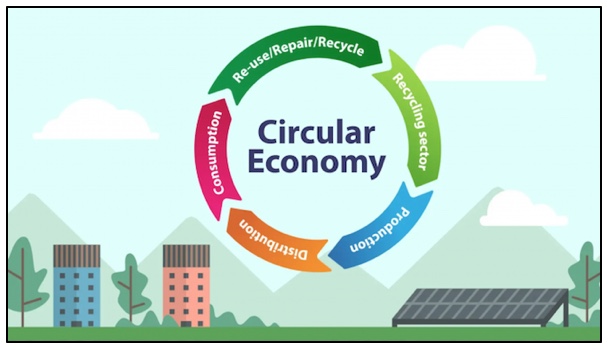
- to provide consumers and electronics repair shops with replacement parts, software and tools for diagnosing, maintaining or repairing their products for a fair price;
- to provide electronic documents such as repair manuals for free, and
- to reset any electronic security that may disable a device during diagnosis, maintenance or repair. Similar legislation has been enacted in France and proposed in 18 US states.
Action: Invite public input into a possible BC Recycling Sales Tax on every product, graded according to its Circular Economy Score. Products that are easy to repair, re-use and recycle would pay a lower tax than those that are harder or impossible, applying the principle of Extended Producer Responsibility across the economy. Revenues would be used to pay for recycling and composting.
Action: Create a $10,000 grants program to encourage ten organizations and libraries to pioneer the best ways to establish Repair Cafés and Libraries of Things, building on BC’s existing success stories, enabling people to share and repair basic domestic items.
Action: Accelerate BC’s Organics Infrastructure Program, supporting composting projects that keep organic wastes out of the landfill, create jobs and reduce carbon pollution.
16. Support Clean Industry
Industry and manufacturing (excluding coal, oil and gas) produce 14% of BC’s climate pollution. Under the CleanBC Industrial Incentive Program, a climate pollution benchmark has been set for each sector. A facility with an emissions intensity below the benchmark may be eligible for an emissions rebate.
Action: Upgrade the climate pollution benchmarks for each industrial sector to reflect the faster rate of climate ambition (65% by 2030, 100% by 2040).
Action: Upgrade the Low Carbon Industrial Strategy, developed in partnership with the BC Business Council, to the new level of climate ambition.
Action: Implement the forthcoming Hydrogen Strategy, and develop a regulatory framework to deliver clean hydrogen sourced from renewable electricity, not dirty hydrogen sourced from natural gas. Continue to support clean hydrogen research, development and deployment, as recommended by Clean Energy Canada.
Fossil Fuel Extraction and Exports
The extraction of fossil fuels produces 23% of BC’s climate pollution. The export of coal adds to our already heavy climate impact footprint. The future export of liquefied natural gas will increase it yet further. As well as ceasing to use fossil fuels, we need to cease extracting and exporting them. To avoid global climate disaster, we need to leave them in the ground.
Action: Endorse the call for a Fossil Fuel Non-Proliferation Treaty, in accordance with the Lofoten Declaration, which affirms that it is the urgent responsibility and moral obligation of wealthy fossil fuel producers to lead in putting an end to fossil fuel development, and to manage the decline of existing production.
17. Continue to Oppose the TransMountain Pipeline
The province has shown great leadership in seeking to prevent federal approval and subsequent construction of the TransMountain Pipeline, which will facilitate and encourage greater oil production in Alberta, at great risk to BC’s rivers and coast.
18. End All Coal-Mining by 2025
In 2019, coal mines in the Kootenay Mountains and the Peace produced some 30 million tonnes of coal, making coal British Columbia’s most valuable mined commodity, with annual sales of $6.3 billion. The combustion of one tonne of coal generates 2.3 tonnes of CO2, so those 30 million tonnes generate 69 million tonnes of CO2 a year – more than BC’s entire non-forest climate pollution. Some coal is combusted within BC, so is included in BC’s climate data, but much is exported.
British Columbia accounts for nearly half of Canada’s coal production, accounting for $3.32 billion of economic activity in 2016. Most is metallurgical coal exported to Asia, where it is used to make steel. Electric cars, solar panels, wind turbines and heat pumps all need steel, but the steel industry is changing in response to the climate crisis. The German giant ThyssenKrupp has demonstrated the use of clean hydrogen to fuel a steel blast furnace, and the Swedish/Finnish company Svenskt Stål AB has plans to end the use of coal by 2026.
Action: Sit down with BC’s coal-miners and community-leaders, explain the dangers of the climate crisis, and discuss arrangements for the closure of all coal mines. Include discussion of income support, retraining for workers, buy-outs for devalued homes and properties, the creation of Citizens’ Assemblies to explore ideas for a post-carbon future, and whatever else is on people’s minds. Recent Climate Citizens Assemblies in France and the UK were very productive.
19. End the Export of Coal from Roberts Bank
The Port of Vancouver operates the Roberts Bank Super-Port, which hosts the Westshore Terminals. In 2017 BC exported more than 36 million tonnes of coal, more than double the amount produced in Mexico, making it the busiest coal export terminal in North America.
The Port also exports thermal coal – 4.4 million tonnes in 2008 rising to 11.3 million tonnes in 2017, when Roberts Bank began exporting thermal coal from mines in Wyoming and Montana. Based on the 2017 data, Vancouver’s annual coal exports will produce 100 million tonnes of CO2 over their lifetime. The dredging, water pollution and construction of the planned Roberts Bank expansion will also threaten salmon, southern resident killer whales, migratory birds, and the Tsawwassen First Nation’s indigenous traditions.
Action: Inform the Port of Vancouver and Westshore Terminals of the government’s intention to phase out all coal production in BC by 2025, and work with the federal government to pass legislation banning the export of coal, whether Canadian or American, by 2025.
20. Withdraw All Government Support for Liquefied Natural Gas
Natural gas is a fossil fuel, and a huge contributor to the global climate emergency. As well as releasing CO2 when burnt, whenever natural gas escapes, whether though leakages, accidental spills or during fracking, it escapes as methane. Methane is a super-polluter that traps 120 times more heat in the atmosphere than CO2 over 12 years, its natural lifespan in the atmosphere. Over 20 years it traps 86 times more heat per molecule; over 100 years it traps 34 times more. Old data that it traps 21 or 25 times more heat are wrong.
When fugitive methane emissions are included in climate pollution calculations, natural gas turns out to be as bad and sometimes worse than coal. And yet the BC government continues to support the LNG industry, accepting:
- A loss of nearly $60 million per year through a subsidized BC Hydro price
- A loss of $60 million a year in reduced carbon taxes
- A 3% cut in corporate income tax
- A $21 million deferral on provincial sales tax
- A loss of $12 billion if the Site C dam, the main purpose of which is to provide power for LNG plants, is abandoned due to unforeseen geological risk factors and consequent cost over-runs.
In his CCPA report BC’s Carbon Conundrum, the energy specialist David Hughes writes that “Even without any LNG exports, and assuming a 15% reduction in upstream emissions through reduced fugitive methane and electrification, emissions from oil and gas production alone would exceed BC’s 2050 climate target by 54%,” and “increasing production for LNG Canada would add 13 MT per year, including the company’s estimate of 3.96 MT from the terminal itself. Including LNG Canada, emissions from oil and gas production would exceed BC’s 2050 target by 160%, even if emissions from the rest of the economy were reduced to zero by 2035.”
The claim that BC’s LNG will reduce China’s climate pollution from coal and produce a net global climate benefit is false. Here’s David Hughes: “Emissions from LNG are 18.5% greater than best technology coal over 20 years and 9.8% less than coal over 100 years. Over the critical next few decades LNG exports will make the global climate problem worse. Even if fugitive methane emissions were reduced to 2% (assuming supply came from conventional, not unconventional fracked gas), LNG exports would make global warming worse over at least the next three decades.” When natural gas is sourced by fracking, as in BC, methane emissions are even higher.
It is possible that LNG Canada will be cancelled because of market forces, since the global market can’t support a price higher than $6 per million BTU, and spot prices have fallen as low as $2, while the estimated price to get Canadian LNG exports to Asian markets is $8-$10.
Action: Withdraw all support for LNG Canada that is legally possible. Tell the public why BC’s LNG industry will increase BC’s climate pollution, making it far harder to achieve our goals. Spell out LNG’s true costs.
Action: Update all provincial data and calculations to reflect the reality that methane’s global warming potential is 120 times greater than CO2 over 12 years, 86 times greater over 20 years, 34 times greater over 100 years. Even the Government of Canada’s data on methane’s Global Warming Potential is outdated.
Action: Require real-time measurements of methane emissions at all natural gas facilities, including fracking operations, and cease using modeled assumptions.
Action: Under current arrangements, the natural gas sector in BC is required to reduce its methane emissions by 45% by 2025. To ensure that this happens, phase in an annually increasing Methane Tax, priced proportionally to account for methane’s greater global warming potential.
Action: Sit down with LNG workers and community-leaders in Kitimat and the Skeena Valley, explain the true dangers of the climate crisis, and discuss arrangements for the possibility that LNG Canada will close, including income support, retraining for workers, the creation of Citizens’ Assemblies to explore ideas for a post-carbon future, buy-outs for devalued homes and properties, and whatever else is on people’s minds.
21. End the Extraction of Natural Gas by 2040
It is essential that all remaining fossil fuels be left in the ground. To continue to produce and export fossil fuels in full knowledge of the climate emergency is equivalent to producing guns and military aircraft for export to Germany during World War 2.
Action: Continue to encourage the development of renewable biogas, while seeking whatever negotiated, regulatory or legal means are possible to end the extraction of natural gas in BC by 2040.
22. End the Extraction of Oil in BC by 2040
The same argument applies to oil extraction. We will never be able to end the climate emergency if we continue to support new extraction of fossil fuels, throwing yet more gas onto the climate fire. In 2018, oil operations in BC’s north-east extracted 2.47 million cubic metres of oil and wellhead condensates (15.5 million barrels, 2464 million litres), generating 5 million tonnes of CO2 when burnt.
Action: Seek whatever negotiated, regulatory or legal means are possible to end the extraction of oil in BC by 2040.
Jobs
23. Provide Transition Support for All Affected Workers
Many jobs will end as coal, oil and gas extraction winds down, but a host of new jobs will be generated as we tackle the climate crisis – retrofitting buildings, installing heat pumps, and if Site C is cancelled, installing new wind, solar and geothermal renewable energy systems.
Clean Energy Canada reports that under existing plans, Canada’s clean energy sector will employ 559,400 Canadians by 2030 in jobs like insulating homes, manufacturing electric buses, and maintaining wind farms. And while 50,000 jobs are likely to be lost in fossil fuels by 2030, 160,000 jobs will be created in clean energy—a net increase of 110,000 new energy jobs. Clean energy jobs are set to grow at 3.4% a year, while fossil fuel jobs decline by 0.5% a year.
Energy Efficiency Alberta shows what’s possible. Its $250 million investment created 5,200 jobs, completing projects that saved Albertans $800 million in energy costs over their lifetime and generating $900 million in economic activity, much of it in wages and virtually all of it taxable.
Albertans leaving the coal industry were offered:
- A bridge to re-employment relief grant
- A bridge to retirement relief grant
- Reimbursement for moving expenses
- A tuition voucher with a maximum value of $12,000 for retraining or further education
- Career consultancy
- A qualified facilitator to assist with setting up a workforce adjustment committee to create plans for individual worksites.
- A $5 million Community Transition Fund for community economic development in the affected communities, with the goal of enabling as many workers as possible to continue working there.
- The problem of falling home values was discussed, but not addressed.
In 2019, 12,600 people worked in oil and gas extraction and related support activities in BC, and 4,460 worked in coal-mining, totaling 18,000 fossil fuel extraction workers. If their jobs are phased out over 20 years, that would be 900 workers a year. If the transition cost for each is $24,000, the average annual cost would be $22 million a year.
Action: Create a Good Jobs Guarantee to protect all affected workers. Ensure that CleanBC’s Jobs Readiness Plan includes income support, retraining and other measures for BC workers leaving fossil fuel industries, similar to Alberta’s actions, and a clear pathway to new jobs in the clean energy economy.
Action: Establish a BC Clean Energy Transition Agency to manage the transition, with its head office in Fort St. John or Dawson Creek.
Action: In addition to Citizens Assemblies in the Peace Country and the Skeena Valley, fund Citizens Assemblies for coal-mining communities in the Kootenays and Tumbler Ridge, enabling local residents to explore and develop a green post-carbon future.
Forestry
Forestry is the elephant in BC’s climate room. Forestry’s climate pollution is huge, but it is not included in BC’s publicly reported climate numbers, rather in a separate off-to-one-side addendum.

The two components that jump out are (Column A) the steady reduction in ‘forest growth minus decay’, caused primarily by the Mountain Pine Beetle that has flourished as a result of the absence of ‘forty below’ winters, and by increased harvesting, and (Column D) the recent dramatic increase in wildfires. BC’s wildfire season in 2019 was fortunately much smaller, but there is every expectation that wildfires will grow in extent and severity, as they are doing in Washington, Oregon and California, and as as they have done very recently Australia, and in Siberia, which experienced record heat waves in 2020.
In Oregon, many wildfires are being referred to as ‘clearcut firebombs’, since “forests with the most logging burned in the highest severities … because logging slash is often left strewn across the landscape and then small trees are densely planted — both act like kindling for fires.”
In response, the government has provided $27 million for 38 different projects to increase the use of fibre that would have been burned as slash, reducing pollution and minimizing wildfire risks.
24. Share BC’s Forest Climate Pollution Data
In the News Release accompanying the Sierra Club’s 2019 report Hidden, Ignored and Growing: BC’s Forest Carbon Emissions, Jens Weiting writes that “Setting reduction targets for forest emissions is difficult. What the government can do is to set and deliver on targets related to actions like protecting forests and changing practices. Examples are targets for protection of carbon rich old-growth, timelines to phase out slash burning, and ensuring all communities at risk of wildfires are fully participating in Fire Smart programs.”
Action: Develop a Provincial Forest and Land-Use Emissions Report, and share it with the public annually to inform forest and land use policy with targets and timelines.
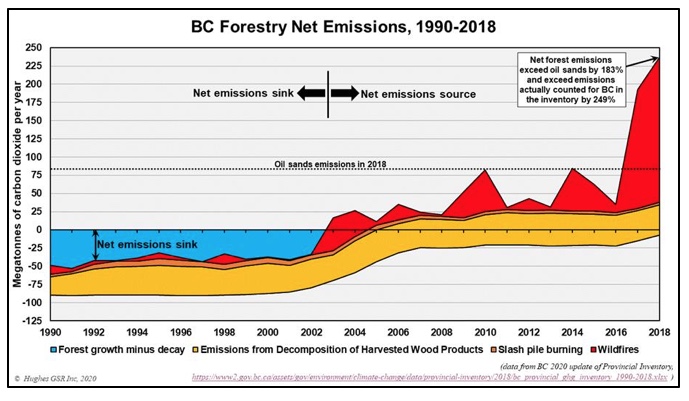
25. Develop a Climate-Compliant Forest Management Strategy
Action: Build on BC’s Forest Carbon Initiative and develop a Climate-Compliant Forest Management Strategy for BC, to maximize the opportunities for BC’s forests to fulfil their critical climate function as a carbon sink. The Green Development Bank of BC could offer 0% interest loans for any necessary changes.
Action: Ensure that the Strategy includes measures to reduce or eliminate clearcutting, which has been shown to accelerate the spread of forest fires, and that it includes the thinning of overstocked secondary forests.
Transportation
Transportation produces 42% of BC’s climate pollution, shared as follows:
- 34% Light-duty cars and trucks
- 32% Heavy-duty vehicles
- 18% Industrial and other off-road vehicles
- 6% Boats and ships
- 5% Flying
- 3.5% Railways
26. Accelerate BC’s Commitment to Active Transportation
The more we walk and cycle, the less climate pollution we produce, the less we suffer from air pollution, and the healthier we are. The Mayor of Paris wants to create a ‘15-Minute City’ with self-sufficient communities in each arrondissement with their own grocery shops, parks, cafés, sports facilities, health centres, schools and even workplaces, all within easy walking or cycling distance. This would reduce pollution, reduce stress, and create socially and economically mixed districts that would improve the quality of life for residents and visitors.
BC’s government has a comprehensive Active Transportation Strategy, but the target – to double trips made by active transportation from 2.5% to 5% by 2030 – is not ambitious enough. Copenhagen, with a population similar to Vancouver and density similar to many urban centres in BC, has set these goals for 2025:
- Relative to 2010, reduce cyclists’ travel time by 15%
- 50% of all trips to work and school to be by bicycle
- Relative to 2005, reduce the number of seriously injured cyclists by 70%
Action: Upgrade the Active Transportation goal to 10% of personal trips by 2030, 25% by 2040. Provide more financial support for municipalities and regional districts to build integrated, accessible, safe separated bike lanes. The additional $17 million funding for active transportation announced in September 2020 is very welcome.
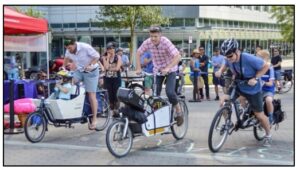 Action: Improve the e-bike incentives, which offer a rebate of $1,050 with the trade-in of a motor vehicle. Remove the requirement for a trade-in, and provide the incentive only to low and middle income residents. Improve the business rebates of up to $1,700 for a cargo e-bike by increasing the range of eligible cargo-bikes and limiting the incentive to 3 e-bikes per business. In Europe, direct e-bike incentives are provided to residents in Sweden, Norway, Austria, France and Germany.
Action: Improve the e-bike incentives, which offer a rebate of $1,050 with the trade-in of a motor vehicle. Remove the requirement for a trade-in, and provide the incentive only to low and middle income residents. Improve the business rebates of up to $1,700 for a cargo e-bike by increasing the range of eligible cargo-bikes and limiting the incentive to 3 e-bikes per business. In Europe, direct e-bike incentives are provided to residents in Sweden, Norway, Austria, France and Germany.
Action: Create a PST exemption for e-bikes, as recommended by the BC Cycling Coalition.
Action: Work with BC’s technical colleges to encourage people to manufacture cargo-bikes in BC.
Action: Amend the 1957 Motor Vehicle Act to improve the safety of cyclists, as recommended by the BC Cycling Coalition.
27. Accelerate the Transition to Electric Buses
An electric bus (average $750,000 US) costs more than a diesel bus (average $550,000 US), but it costs $40,000 less to operate per year, so the additional cost pays for itself over 5 years, followed by an annual saving. Many cities in China have converted their entire fleets to electric, and cities such as New York and Barcelona are only buying electric buses. BC Transit wants its entire fleet to be electric by 2040, replacing 1,200 buses and adding 350 more over the next 10 years. TransLink is planning to achieve a zero-emission fleet by 2050. Compressed natural gas is not a rational option, since the climate pollution from gas is as bad as coal.
There are four electric bus manufacturers in Canada, including GreenPower Motor Company, with its head office in Vancouver but manufacturing in California, where it makes electric minibuses, transit buses and school buses.
Action: Work with TransLink, BC Transit and the federal government to achieve a fully electric bus fleet by 2030, using zero-interest loans to cover the higher purchase cost.
Action: Create incentives to encourage the local manufacturing of electric buses in BC.
Action: Work with BC’s School Boards and the federal government to achieve a similar transition for school buses, with similar zero-interest loans.
28. Advance the Electric Vehicles Mandate from 2040 to 2025
Under current legislation all new light-duty vehicles sold or leased in BC must be zero emissions by 2040. 10% of light-duty vehicle sales must be electric by 2025, and 30% by 2030.
 2040 is a lazy goal. It sends the message “Why worry? No hurry.” It does nothing to address the urgency of the emergency or motivate people to change. Consumer reports suggest that by 2025 there will be a large range of EVs on the market with a range of 400 km, and many will be cost-competitive with conventional cars. A 2019 report by Bloomberg New Energy Finance estimates that they will be cost-competitive by 2022, due to the plunging price of batteries. Researchers at Carnegie Mellon University estimate 2023, definitely 2025. Über and Lyft have both made a commitment that all their vehicles will be electric by 2030.
2040 is a lazy goal. It sends the message “Why worry? No hurry.” It does nothing to address the urgency of the emergency or motivate people to change. Consumer reports suggest that by 2025 there will be a large range of EVs on the market with a range of 400 km, and many will be cost-competitive with conventional cars. A 2019 report by Bloomberg New Energy Finance estimates that they will be cost-competitive by 2022, due to the plunging price of batteries. Researchers at Carnegie Mellon University estimate 2023, definitely 2025. Über and Lyft have both made a commitment that all their vehicles will be electric by 2030.
Driving an electric vehicle costs six times less than a gas-powered vehicle, saving $1500 a year in reduced fuel and servicing costs. Over ten years, based on the current low carbon tax, this is a $15,000 saving in an EV owner’s pocket. As the carbon tax increases, the annual saving for EV drivers will increase.
As a hint of what’s coming, a GM-backed two-seater electric car that costs $4,100 US in China sold 15,000 units within 20 days of its launch and received 50,000 further orders (see image). A small French urban mini-EV with a speed limit of 45 kph and a price of $6,000 sold 500 in the first two weeks. Four other EVs for sale in China and India cost $20,300 or less. The new Tesla 4680 battery, announced in September 2020, will increase range by 16% and reduce cost by 14%.

Electric vehicles are also important in reducing the spread of Covid-19, since air pollution from gasoline and diesel vehicles is a known accelerant for Covid-19.
What are other nations doing? Norway is planning to phase out all new gasoline vehicles by 2025. Germany, Denmark, Iceland, Ireland, India, Israel, Holland, Slovenia and Sweden have adopted a 2030 phase-out date. Britain is expected to advance its phase-out date from 2040 to 2030 this fall.
Action: Advance the ZEV Mandate date to 2025, but make it flexible, conditional on the average cost of a new EV being similar to the average cost of a conventional car, weighted for consumer use so that luxury cars don’t skew the cost upwards. To discourage rule-breaking imports, impose an ICBC Climate Danger Insurance Surcharge on all new light-duty vehicles imported into BC after 2025. A 2018 BC Hydro report found that 33% of British Columbians expect their next car to be an EV. In 2019 9% of new vehicles sales in BC were EVs.
Action: Accelerate the province’s rebates to install public EV charging stations across the province, and continue the $5 million incentive for home and work EV charging stations.
Action: Accelerate CleanBC’s electric vehicle training program for automotive technicians at BCIT, which trains green fleet technicians who support the City of Vancouver’s municipal EV fleet.
29. Change the ZEV Incentive to a Vehicle Feebate
Action: To reduce the impact on BC’s budget, replace the current $3,000 CEVforBC purchase incentive and new utility vehicle incentives with a revenue-neutral feebate, as recommended by Clean Energy Canada. All conventional vehicles would be subject to a fee based on the amount of climate pollution they produce, and the income would be distributed as a purchase rebate to EV buyers, using a means-test to exclude wealthier buyers. Data shows that a $1,000 fee or rebate causes a 30%-40% reduction or increase in the market share of a vehicle. Such a change would enable annual savings to the government of $41.5 million.
30. Accelerate the Transition to Electric Trucks
BC’s 66,000 heavy-duty vehicles produce 32% of BC’s climate pollution from road transportation. Fuel is one of the industry’s highest operating costs, so BC has partnered with the BC Trucking Association to deliver the CleanBC Heavy-Duty Vehicle Efficiency Program to cost-share on fuel-saving equipment for heavy-duty vehicles, reducing fuel costs and climate pollution.
 What will it take to make the transition to electric light and heavy duty trucks? Light trucks are available from Lion Electric (Quebec) and other companies. Heavy duty trucks are available from Freightliner/Daimler (see left), BYD, Volvo and Mercedes Benz. The companies Rivian, Tesla, Nikola Corp and General Motors are also in the race to produce heavy duty electric trucks.
What will it take to make the transition to electric light and heavy duty trucks? Light trucks are available from Lion Electric (Quebec) and other companies. Heavy duty trucks are available from Freightliner/Daimler (see left), BYD, Volvo and Mercedes Benz. The companies Rivian, Tesla, Nikola Corp and General Motors are also in the race to produce heavy duty electric trucks.
Action: Continue the Go Electric Vehicle Incentive Program, which offers incentives of up to $50,000 for electric trucks and other specialty electric vehicles.
Action: Follow California’s example by adopting a heavy-duty trucks mandate that would require 5% to 9% of all new heavy-duty vehicles to be zero emissions based on class in 2024, rising to 30%-50% by 2030 and 100% by 2040 for all vehicles, dependent on technological and financial feasibility.
Action: Create incentives to encourage the local manufacturing of electric trucks in BC.
Action: Offer zero-interest loans to BC companies to buy electric trucks.
31. Accelerate the Transition to Electric Ferries, Boats and Ships
Ships and boats produce 2.5% of BC’s climate pollution, so we need to accelerate the transition here as well. The increasing carbon tax will play a persuasive role, but more is needed. CleanBC is aiming to achieve full electrification of the inland ferry fleet by 2040, starting with an electric-ready vessel for Kootenay Lake that will be able to take 50 to 60 vehicles. The world’s largest electric ferry connects the ports of Søby and Fynshav in southern Denmark. It is capable of carrying 30 vehicles and 200 passengers, using a 4.3MWh battery system. The Swedish shipping giant Wallenius is planning an ocean-going cargo-ship, the Oceanbird, with 80-metre sails that would reduce emissions by as much as 90%, at the price of travelling at 10 knots, instead of faster.
 Action: Work with BC Ferries to speed its transition to 100% electric ferries.
Action: Work with BC Ferries to speed its transition to 100% electric ferries.
Action: Work with the Boating BC Association to encourage its members to go electric. Vision Marine Technologies, based in Montreal, sells five types of small electric boat. LTS Marine, based in Sainte Catherine, Quebec, sells three types of electric power boat.
Action: Create incentives to encourage the conversion of boats to electric, and the local manufacturing of electric boats and ferries.
32. Accelerate the Transition to Electric Aviation
Harbour Air, North America’s largest seaplane airline, which flies out of Victoria, is partnering with Seattle-based electric aviation company magniX to transform its entire fleet of de Havilland Beavers into zero-emission e-planes. The European aviation giant Airbus has announced that zero-emission commercial aircraft that run on hydrogen that could take to the skies by 2035.
Action: Work with the BC General Aviation Association, the Canadian Owners and Pilots Association and other Aero Clubs to encourage their members to go electric.
Action: Continue the PST rebate for electric battery aircraft.
Action: Create incentives to encourage the local manufacturing of electric planes.
Action: If BC has the jurisdictional power to discourage non-essential flights, ban the use of Air Miles and similar frequent flyer reward schemes, starting in 2022. There are 220 frequent flyer clubs across the world with an estimated membership of 200 million, many of whom take additional flights to maintain their status.
33. Raise the Low Carbon Fuel Standard
British Columbia’s low carbon fuel standard works to reduce the carbon intensity of diesel and gasoline, setting carbon intensity targets that decline each year. Fuel suppliers generate credits for supplying fuels below the targets, and debits for fuels above the targets, taking the full life cycle of the fuel into account. At the end of each compliance period, to avoid penalties suppliers must have a zero or positive balance. The current targets aim to achieve a 20% reduction in climate pollution by 2030.
Action: Raise the targets to achieve a 65% reduction in climate pollution by 2030, 100% by 2040.
Action: Ensure full lifecycle GHG data transparency on imported biofuels, to remove the concern that biofuels are being made from palm oil plantations established by the destruction of tropical rainforests, and that certification of a plantation by the Roundtable on Sustainable Palm Oil is meaningless if the plantation occupies land that was forest and/or wildlife habitat as recently as 30 years ago.
Electricity
34. Accelerate the Transition to Renewable Energy in Off-Grid Communities
BC Hydro’s grid-connected power operates on almost 100% renewable energy from hydro, wind and solar, which is why this paper does not call for more wind and solar. Most of BC’s off-grid communities are still burning diesel to generate power and heat, however, producing 1% of BC’s climate pollution, so that diesel needs to be replaced with renewable energy.
The current goal is to reduce province-wide diesel consumption for electricity in remote communities by 80%, with financial support from BC’s Renewable Energy for Remote Communities program and First Nations Clean Energy Business Fund, which in 2018 helped kick-start 14 Indigenous-driven projects for run-of-river hydropower, hybrid smart-grid solar PV+ battery systems and energy-efficiency planning.
Action: Increase the off-diesel goal to 100% by 2030, to eliminate climate pollution on Haida Gwaii and elsewhere. Offer zero-interest loans from the Green Development Bank to assist the change.
35. Accelerate Initiatives to Help Indigenous Communities End Climate Pollution
Many BC Indigenous communities use diesel or inefficient baseboard heaters for heat, which can be eliminated by a home efficiency upgrade and an air-source or ground-source heat pump.
To show what’s possible, Aki Energy is a First Nations social enterprise based in Winnipeg whose members have installed 350 geothermal heat systems in Manitoba First Nations, laying 213 kilometres of pipe that will cut utility bills by $15 million over 20 years, generating many well-paid jobs and reducing energy bills.
Build Inc is another Winnipeg-based First Nations social enterprise that operates an insulation and home retrofit contractor and training program for Indigenous people who face barriers to employment, whose work lowers utility bills, employs neighbourhood people, cuts crime and decreases climate pollution.
Action: Work with the BC Ministry of Indigenous Relations and Reconciliation and with Indigenous Services Canada:
- To remove barriers to the approval of Indigenous community-based and social enterprise contracts and investments;
- To allow PAYS financing in partnership with BC Hydro and FortisBC for retrofits by First Nations social enterprises;
- To ensure that contracts for home retrofits and renewable energy projects can be given to social enterprises, and that contractors are able to hire ex-inmates, people who experience mental health and substance abuse challenges, and people who have no high school diplomas, poor literacy skills, no drivers license, no work experience and no hope;
- To accelerate applications to BC’s First Nations Clean Energy Business Fund, supported by zero-interest loans from BC’s Green Development Bank.
Buildings
Buildings generate 10% of BC’s climate pollution, caused by the burning of oil and gas for heat. CleanBC requires that all new buildings in BC are net-zero-energy ready by 2032. The government has made awards through the Net-Zero Energy-Ready Challenge that support the design and construction of Challenge-winning buildings that will be built to the highest energy performance standards. CleanBC also supports building innovation through the Building Innovation Fund, which was granted $8 million in new funding in the September 2020 Stronger BC Economic Recovery Plan.
The problem with 2032 is that almost every building built before 2032 will use natural gas for heat, adding yet more climate pollution, increasing the climate crisis instead of reducing it. 2032 is a far-away goal that tells the building industry that really, there’s no hurry, no need to worry, no need to learn new skills.
36. Require all New Buildings to Release Zero Climate Pollution by 2022
 The Passive House standard, widely accepted throughout the world, enables the construction of new buildings so efficient that they need no additional heat: just a heat-recovery ventilator that transfers heat from the outgoing air into the incoming fresh air. They cost 0%-5% more to build, but with no heating bills, the additional cost zeroes out within a number of years. The city of Brussels has shown that the Passive House standard can work for an entire city of two million people. They made the decision in 2011, gave carpenters four years to learn the new skills, and since 2015 every new building in Brussels, large or small, has been built to this standard.
The Passive House standard, widely accepted throughout the world, enables the construction of new buildings so efficient that they need no additional heat: just a heat-recovery ventilator that transfers heat from the outgoing air into the incoming fresh air. They cost 0%-5% more to build, but with no heating bills, the additional cost zeroes out within a number of years. The city of Brussels has shown that the Passive House standard can work for an entire city of two million people. They made the decision in 2011, gave carpenters four years to learn the new skills, and since 2015 every new building in Brussels, large or small, has been built to this standard.
Action: Upgrade BC’s building code and BC’s Energy Step Code to require every new building large or small to be built to thePassive House Standard or an equivalent zero carbon energy standard by 2022, rather than 2032, and to base the code on future (not past) climate conditions. This should include all new public buildings such as schools, hospitals, fire and police stations. Allow building owners where design work had incurred an investment above $50,000 at the time of the announcement to apply for an exemption.
Action: To develop Passive House building skills, provide development grants to BC’s technical colleges and schools of architecture to expand the content and reach of courses for architects, engineers, builders, project managers, software developers, trades workers and building inspectors, enabling them to acquire Passive House skills and knowledge.
Action: Ensure that all new affordable housing projects in BC are built to the Passive House standard. Successful examples can be found in Philadelphia, Hamilton, Vancouver, Boston, and elsewhere.
37. Require Building Energy Labelling
How energy efficient is the house I am considering buying? There’s no way of knowing, unless the owner has done a voluntary energy audit. For many years the government has been holding meetings on the merits of Building Energy Labelling, but without any resulting action. Building energy labelling has been required throughout the European Union since 2002, and the City of Berkeley in California has been using residential and commercial energy conservation ordinances since the 1980s, requiring conformance to the code at the point of sale or major renovation, stimulating an average 10% reduction in energy consumption.
Action: Just do it.
38. Develop a Province-Wide Strategy for Mass Deep Energy Retrofits
The bigger challenge is to retrofit every building in BC that burns oil, gas or wood for heat, which every year adds more climate pollution, increasing the emergency.
The government is improving 50,000 public housing units over the next 10 years to make them more efficient, comfortable and affordable. It also has a rolling five-year plan to make courthouses, correctional centres, warehouses and ministry offices 80% more energy efficient by 2050. In thirty years time. Again – no hurry, no need to worry.
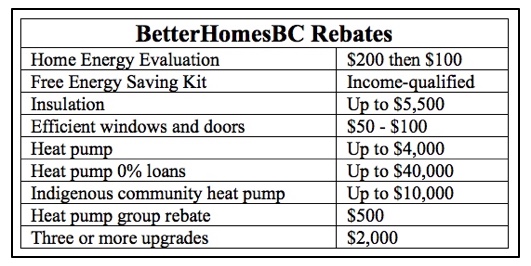
The piece that’s missing is any overall strategy or requirement. To meet even the current goal of a 40% reduction in climate pollution by 2030 and 80% by 2050 the Pembina Institute has calculated that every year between 2020 and 2050 we will need to retrofit:
- 30,000 houses
- 17,000 apartments
- 3 million square feet of commercial space.
To achieve a 65% reduction by 2030 and 100% by 2040, every year we will need to retrofit:
- 45,000 houses
- 25,500 apartments
- 4.5 million square feet of commercial space.
To drive home what this means, Salt Spring (12,000 residents, 5,000 homes) would need to retrofit 250 homes a year, or 5 homes a week. The City of Vancouver, (610,000 residents, 250,000 homes) would need to retrofit 12,500 homes a year, or 250 homes a week. The rational way to approach such large numbers is through a mass deep retrofit program, in which teams of workers retrofit many homes on a block at the same time, generating efficiencies in labour, materials and costs.
Every dollar spent on an energy-efficiency retrofit program generates between $4-$8 of gross domestic product, and industry data suggests that every $1 million invested supports 20 jobs (direct, indirect and induced), so tens of thousands of new jobs would be created if BC adopted a determined approach to achieve mass deep zero-carbon retrofits.
Action: Establish a Mass Deep Retrofits Training Consortium with representatives from government, industry, universities and colleges, and charge it with developing a strategy for mass deep energy retrofits, in preparation for the establishment of a new Crown Corporation.
39. Establish a New Crown Corporation: RetrofitBC
Action: Establish RetrofitBC as a new Crown Corporation and task it to deliver mass, deep neighbourhood-scale retrofits on the scale needed to eliminate the need for oil heating by 2025 and gas heating by 2040. It would:
- Assume effective operation of BetterHomesBC.
- Work with municipalities and non-profits such as City Green and Lighthouse to establish regional and local Green Building Hubs with trained advisors to offer information and guidance.
- Calculate how many heat pumps, energy-efficient windows, doors and related equipment will be needed, and how much insulation. Set up discussions with local manufacturers and importers to meet the demand, and arrange bulk purchases at discounted wholesale prices.
- Negotiate with heat-pump manufacturers to open BC-based manufacturing plants, or form a crown corporation to make quality heat-pumps in BC.
- Work with municipalities, community associations, non-profits and contractors to develop street-by-street plans for mass deep retrofits, reducing costs by the aggregation of projects, logistics and financial support.
- Work with LandlordBC to ensure that rental properties are included in the plans.
- Work with the Condominium Home-Owners Association of BC to ensure that condos are included in the plans.
- Work with BC Housing to ensure that public housing is included in the plans.
- Offer homeowners and landlords free or low-cost ‘pre and post’ Energy Audits.
- Fund a province-wide home retrofit advertising campaign to build demand.
- Increase contractor training, accelerate the use of on-line training tools, and build a qualified workforce, including youth, women, indigenous people and new Canadians.
- Work with the federal government to achieve faster and easier licensing for immigrant engineers.
- Provide Retrofit Training Development Grants to colleges to develop on-line training courses.
- Work with the federal government to fast-track R&D in innovative retrofit products and demonstration projects, leading to rapid certification and the commercialization of innovative technologies.
40. Develop New Retrofit Financing Mechanisms
Most home owners’ initial assumption is that a retrofit will be very expensive. RetrofitBC should develop whatever policies are needed to enable the cost to be covered through the energy savings. The rising carbon tax will help, increasing the price of oil and gas while returning the tax paid as an annual rebate. Many additional measures can be used to reduce the cost.
Actions:
- Work with the Green Development Bank to offer zero-interest loans to enable retrofit companies and contractors to ramp up their activities.
- Create a provincial tax credit for zero-carbon retrofits.
- Offer industrial, commercial and institutional building retrofit loans to building owners.
- Empower utilities and landlords to contract with Energy Service Companies (ESCOs) and social enterprises to do building retrofits, financed through energy savings, with estimates for future financial energy savings being protected by insurance.
- Work with the federal government to accelerate the promised retrofit loans of $40,000, and to offer a federal tax credit for a retrofit investment.
- Waive PST on retrofit components such as heat pumps, insulation, energy-efficient windows and doors, air sealing and heat recovery ventilators.
- Work with BC’s banks and credit unions to ensure that home retrofits can be financed through the easy use of a home equity line of credit by those who own property.
- Work with the Pembina Institute the PACE BC Coalition to establish a clear legal framework for Property Assessed Clean Energy (PACE) financing, enabling a retrofit loan to be repaid by a charge on property tax that runs with the property, not the owner.
- Work with BC Hydro and Fortis BC to enable the easy use of Pay-As-You-Save (PAYS) financing, enabling a retrofit loan to be repaid by a charge on the occupier’s hydro bill.
- Work with the federal government and CHMC to relax the mortgage test rules for zero-carbon homes that have lower or no heating bills.
- Work with the federal government to allow homeowners to invest up to $25,000 of their RRSP tax free in a zero-carbon retrofit, whether their own or someone else’s.
- On the premise that most mobile homes are not worth retrofitting, work with CMHC to create zero-interest loans to enable mobile home owners to replace them with zero-net-energy modular homes.
- Research the viability of creating a Crown Corporation to build zero-net-energy manufactured homes and tiny homes in BC.
- Offer District Heat development grants and zero-interest loans to enable BC municipalities to develop renewable energy district heat systems for high density residential and commercial developments, as many European cities are doing.
41. Enact New Retrofit Legislation
Actions:
- To drive home the sense of urgency, legislate the phase-out of oil furnaces by 2025, accompanied by an annually-increasing Climate Danger Levy on their continued use. Use 100% of the revenue to further incentivize the switch to heat pumps.
- Follow Vancouver’s example, and require that starting in 2025, whenever a furnace or water heater needs replacing, it can no longer be replaced by a gas-powered appliance.
- Fast-track the development of a BC Retrofit Code that emphasises deep retrofits to zero carbon, not shallow retrofits that require the continued use of oil and gas for heat.
- Revise condo strata-title legislation to make it easy for condo owners to invest in a retrofit.
- Enact Tenants Renovation Security legislation to ensure that if tenants need to live elsewhere during a retrofit, their landlord will work with their municipal government to ensure that alternative rental arrangements are available, and that he/she will honour the post-retrofit tenancy at the same rent.
42. Recruit 5,000 Youth Retrofit Rangers
Action: Work with BC’s colleges to train 5,000 young people to become Retrofit Rangers, similar to the Climate Rangers, young people who would volunteer for two years of service, with pay similar to the Canada Emergency Response Benefit (CERB). The Retrofit Rangers would receive nine months free retrofit training, followed by the opportunity to join a retrofit business or move on to free higher education. The cost of 9 months of CERB equivalent ($18,000) for 5,000 Youth Retrofit Rangers would be $90 million a year.
Agriculture
Most farms produce very little climate pollution. Those that have a larger footprint generate 4% of BC’s climate pollution, which comes from:
- Cattle burping methane gas (59%)
- Nitrogen oxide emissions from cattle manure (17%)
- Loss of carbon from poor soil management (22%)
- Buildings and equipment
The BC Agriculture and Food Climate Action Initiative is a great resource for farmers, and is very active in helping farmers adapt to the warmer climate, which will bring more frequent droughts, heat-waves and insect infestations. What it does not do is establish any goals to reduce farming’s climate pollution, or to increase farming’s ability to sequestrate carbon from the atmosphere.
43. Incentivize Carbon Storage in the Soil
As stated above, we face not one climate challenge, but two:
1: Reduce our annual climate pollution to zero.
2: Reduce Earth’s atmospheric carbon to its pre-industrial level, from 900 Gt to 600 Gt.
 When a country, province or corporation announces that it will plant trees to absorb its emissions it is muddling the two challenges. We need to reduce our climate pollution to zero AND sequestrate the excess carbon we have poured into the atmosphere. If the entire world reduced its climate pollution to zero by 2040 the atmospheric pollution would remain, trapping heat, only slowly being sequestrated back to Earth by the natural function of oceans, soils and forests. Terms such as ‘carbon neutral’ and ‘net zero carbon’ erroneously imply that planting trees to capture carbon offsets the need to reduce emissions. To think this way is a categorical carbon error.
When a country, province or corporation announces that it will plant trees to absorb its emissions it is muddling the two challenges. We need to reduce our climate pollution to zero AND sequestrate the excess carbon we have poured into the atmosphere. If the entire world reduced its climate pollution to zero by 2040 the atmospheric pollution would remain, trapping heat, only slowly being sequestrated back to Earth by the natural function of oceans, soils and forests. Terms such as ‘carbon neutral’ and ‘net zero carbon’ erroneously imply that planting trees to capture carbon offsets the need to reduce emissions. To think this way is a categorical carbon error.
This is where BC’s farms can play such an important role, since increased sequestration can be achieved by changed management in farms and ranch lands, as well as in forests, wetlands, peatlands and marine ecosystems.
Farmers need to adopt farming practices that build organic matter in the soil and to practice zero-till cultivation creating minimal soil disturbance. Ranchers need to adopt holistic or management-intensive grazing of cattle and other animals, encouraging grazers to impact the soil very heavily in a limited fenced area, fertilizing it with their manure before moving on to another fenced area.
Action: Work with regenerative farmers to develop a system of Soil Carbon Certification, and use it to encourage changes and initiatives that increase farmland soil carbon, supported by grants and tax incentives.
44. Plan a Full Transition to Regenerative Organic Farming
The health, viability, and productivity of our farms and ranch lands is critically important, yet the way we practice agriculture and ranching is a major cause of both the climate emergency and the biodiversity/ecological emergency. Unsustainable farm practices are contributing to dramatic declines in bird and insect populations, including critically important pollinators, and to the loss of topsoil fertility. The use of chemical pesticides has also been linked to a number of diseases, including cancer and Parkinson’s.
A rapid transition to sustainable, climate-friendly farming practices is essential, but it will present a big challenge to farmers who have evolved their practices over many decades.
Studies show that regenerative organic methods of farming can produce similar yields while storing carbon in the soil, producing no climate pollution, and allowing nature to regenerate. Forty years of side-by-side trials by the Rodale Institute in Pennsylvania have found that after a five-year transition, the yields from organic farming are competitive with conventional farming, and that in drought years, yields can be up to five times higher. After the crippling floods in 2019, sustainable farm operations in the U.S. Midwest recovered faster than conventional farms.
The Rodale Institute has shown that organic farmers can also earn three to six times greater profit, use 45% less energy, and reduce their carbon emissions by 40%. In 2016, the Institute’s no-till organic manure systems produced 200 bushels of corn per acre, almost twice the yield of a conventional no-till system. In the Indian state of Sikkim (population 620,000), which has been 100% organic since 2016, a few crop yields fell, but most increased. Bee populations are said to be rebounding, with plants dependent on bee pollination like cardamom providing much higher yields.
Studies also show that small-scale agro-ecological farming methods are profitable and productive, while storing carbon in healthy soil, conserving water, protecting bees and other pollinators and eliminating the use of chemical pesticides. The American soil scientist Rattan Lan has suggested that over time, globally restored farm soils could recapture as much as 65 ppm of atmospheric CO2, reducing the level from 420 to 355 ppm.
Research shows that regenerative, holistic methods of ranch land management build soil-health, store more carbon, restore ecological functions and increase biodiversity. A 2013 study found that compared to conventionally managed farms,regenerative farms in Mexico could accommodate more cattle per acre, had lower cow and calf mortality, purchased less feed and used fewer herbicides, and that their topsoil was deeper, more aerated and more densely covered with plants.
Action: Establish a Regenerative Farmland Transition Council. Task it to research, cost and implement a full transition to organic regenerative farming and holistic ranch land management by 2040.
Action: Introduce a steadily increasing tax on chemical pesticides and fertilizers. Use the revenue to create a Regenerative Farming Transition Fund to support farmers and ranchers for up to five years, based on yields.
Action: Work with farmers to rapidly phase out those chemical pesticides that have been shown to cause harm to humans, wildlife and pollinators.
Action: Establish a Regenerative Farming Research Fund to develop solutions to problems as they arise.
45. Reduce Farm Methane Emissions
Methane from cows, pigs and sheep produces 59% of BC’s farm-related climate pollution. In New Zealand’s Cawthron Institute, research is being conducted into the ability of seaweed-enhanced diets to reduce methane emissions by as much as 80% when added as a feed supplement at quantities as low as 2%. Other methods yield reductions of 10-20%.
Action: Establish a Seaweed Partnership with the BC company Cascadia Seaweed and the Cawthron Institute to research the methane-reducing potentials of different native seaweeds, and commercialize the best.
Action: Establish a BC reduction target for biogenic methane climate pollution similar to New Zealand’s goal, which to reduce biogenic methane by 10% by 2030, 24-47% by 2050.
46. Encourage all Farms to Embrace 100% Renewable Energy
Farms use a huge variety of equipment, and there are a host of ways in which farmers can use renewable energy, including for tractors, bailers, buildings, greenhouses, lights, heat-pads, pumps, fans, ventilators, refrigeration, driers, electric fencing and hot water. Solar, wind, biomethane and biodiesel can all contribute.
Action: Establish a Renewable Energy Farming Initiative, bundling and incentivizing a wide range of zero carbon farm technologies.
Carbon Sequestration
47. Set a Provincial Goal for Carbon Sequestration and Storage
As a world, we need to get 300 billion tonnes of heat-trapping carbon back down to earth and safely stored away, returning the atmosphere to its previously safe level of 280 parts per million of CO2. This is the work of 100 years, but it needs to start immediately. Every nation should be setting parallel goals for climate pollution reduction and carbon sequestration. BC could pioneer the way, becoming the first to do so.
The heat-trapping carbon can be sequestrated from the atmosphere in six ways:
- By changed methods of farming and ranching (see above).
- By changed methods of forestry (see above).
- In marine ecosystems, through the restoration of eelgrass, seaweed and salt marshes (blue carbon).
- In building timber, hempcrete, biofibre, and other carbon-storing products.
- In engineered systems such as Squamish-based Carbon Engineering and Burnaby’s Svante.
- By carbon capture from industrial sources combined with secure geological storage.
Action: Establish a partnership with the Pacific Institute for Climate Solutions to research the comparative cost of carbon-storage for each method, and to establish carbon sequestration targets for 2030 and 2040.
Action: Establish a partnership with the Blue Carbon Initiative to achieve increased marine carbon restoration in BC, including marine permaculture.
Action: Continue to encourage more use of mass timber. In 2019, 12 B.C. communities and UBC agreed to adopt innovative and safe mass timber technology for taller wood buildings.
Action: Continue to support research in innovative engineering companies, provisional on the relative cost per tonne of carbon captured. Carbon Engineering does not plan to store its captured carbon but to use it as jet fuel. This is an important carbon pollution reduction, but not permanent carbon sequestration.
Impacts, Adaptation and Restoration
48. Require Climate Impact Scorecards and Sustainable Procurement
Governments spend a lot of money, providing a useful opportunity to support provincial policy goals.
Action: Whenever a municipal, regional or provincial government spends public money on a project or investment over $1 million it should be required to complete a Climate Impact Scorecard, describing whether the proposed investment will increase or reduce climate pollution. Projects that increase pollution should not be approved.
Action: Establish a Sustainable Procurement Duty for all government purchasing contracts over $1 million, as the Scottish government has done. The Duty would require that before a contracting business or agency supplies anything to the government it must demonstrate how the expenditure will improve the social, environmental and economic wellbeing of the area in which it operates, with a particular focus on reduced climate pollution, the involvement of small and medium enterprises and social enterprises, the promotion of innovation, reduced inequality, and the hiring of people who experience barriers to employment. These types of condition are also known as Community Benefit Clauses.
49. Combine Climate Adaptation with Ecological Restoration
We face an ecological emergency as well as a climate emergency. Because of our human behaviour, Earth is in the midst a mass extinction crisis: up to a million species are threatened with extinction, many within decades.
The oceans are also in crisis. The ocean is absorbing 90% of the heat trapped by climate pollution, and 20% to 30% of the increased carbon dioxide, making the water more acidic and hostile to shellfish, corals and other marine species. Climate action initiatives on forestry and farms will help protect and restore land-based nature; similar efforts are needed to restore BC’s ocean wildlife and biodiversity.
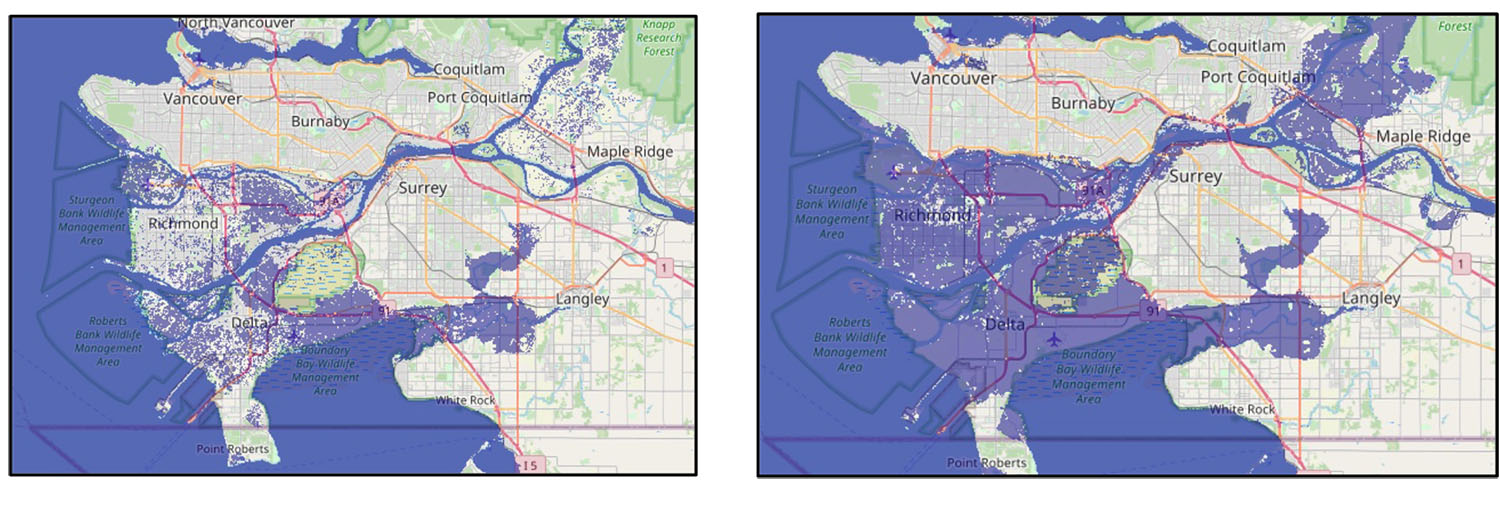
BC’s Preliminary Climate Risk Assessment, published in 2019, is intended to ensure that BC is prepared for 15 climate risks in the 2050s, including riverine flooding, severe wildfires, seasonal and long-term water shortages, heat waves, ocean acidification, glacier loss, the loss of forests, saltwater intrusion from sea-level rise, coastal storm surges, and the spread of Lyme disease.
The assessment assumes a 0.5 metre sea-level rise by 2050, but it only addresses the need to prepare for saltwater intrusion. Based on current trends, the sea-level could be well over 2 metres higher by 2100, and continue rising. The last time the world was 3 degrees warmer the sea-level was 25 metres higher. Floodmap, using data from NASA, shows what a 2-metre sea-level rise looks like for the Lower Mainland and a later 5-metre sea-level rise.
This is just one example of the many disasters the climate emergency will bring, and why climate plans all over the world must embrace far greater urgency.
Action: In preparation for the UN Biodiversity Conference in China in May 2021, re-affirm BC’s commitment to support Canada’s goal to protect and restore 30% of Canada’s land ecosystems by 2030, 50% by 2050.
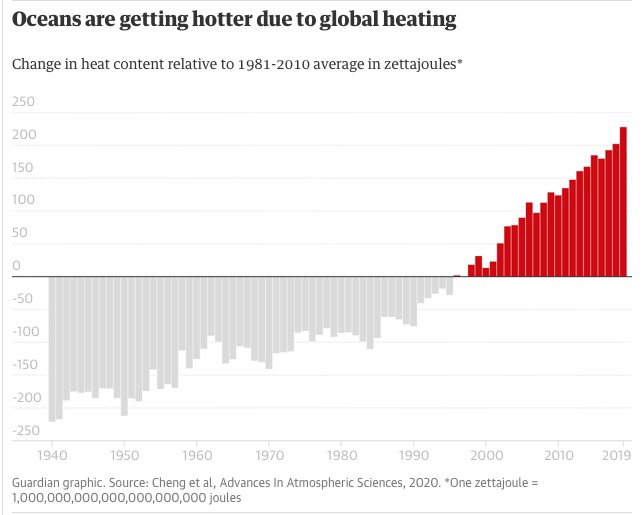 Action: Similarly, re-affirm BC’s commitment to support Canada’s goal to establish Marine Protected Areas (MPAs) to protect and restore 30% of Canada’s marine waters by 2030, 50% by 2050. Only 14% of Canada’s waters currently have some degree of protection. MPAs protect species, habitats and ecosystems, sheltering ocean life and habitats so that they can recover from pollution or overfishing. They are off-limits to industrial uses, including oil and gas extraction, commercial fishing and seabed mining.
Action: Similarly, re-affirm BC’s commitment to support Canada’s goal to establish Marine Protected Areas (MPAs) to protect and restore 30% of Canada’s marine waters by 2030, 50% by 2050. Only 14% of Canada’s waters currently have some degree of protection. MPAs protect species, habitats and ecosystems, sheltering ocean life and habitats so that they can recover from pollution or overfishing. They are off-limits to industrial uses, including oil and gas extraction, commercial fishing and seabed mining.
Action: Prepare new Flood Maps for all coastal communities based on recently observed faster melting in Antarctica, Greenland and Arctic, causing a possible 2.5 metres sea-level rise by 2100. The melting Greenland Ice Sheet is already past the point of no return, with the annual snowfall that replenishes the ice sheet being insufficient to restore ice flowing into the ocean.
Action: Designate critical areas of BC as High Fire Risk Areas, and consult with members of UBCM on the best means to require every community within the area to establish a FireSmart Board, undertake FireSmart training, and develop a FireSmart Community Plan by June 2022, to reduce the wildfire risk to their community, neighbourhoods and individual homes.
Action: Impose a municipal tax surcharge on homes in High Fire Risk Areas, to be waived when the owner provides photographic evidence of a cleared defensible space around the property. Use 100% of the income to provide Defensible Space Grants for low-income households.
50. Recruit 5,000 Youth Restoration Rangers
Action: Work with municipalities, parks departments and non-profits to recruit 5,000 Restoration Rangers, young people who would volunteer for two years to assist local ecological restoration and climate adaptation efforts, with pay similar to the Canada Emergency Response Benefit (CERB), at the end of which they would be rewarded with free college education or skills training. If each of the 5,000 Youth Restoration Rangers was paid $24k a year, equivalent to CERB, the cost would be $120 million a year.
THE END
Appendix: A Rough-Cut Estimate of Costs
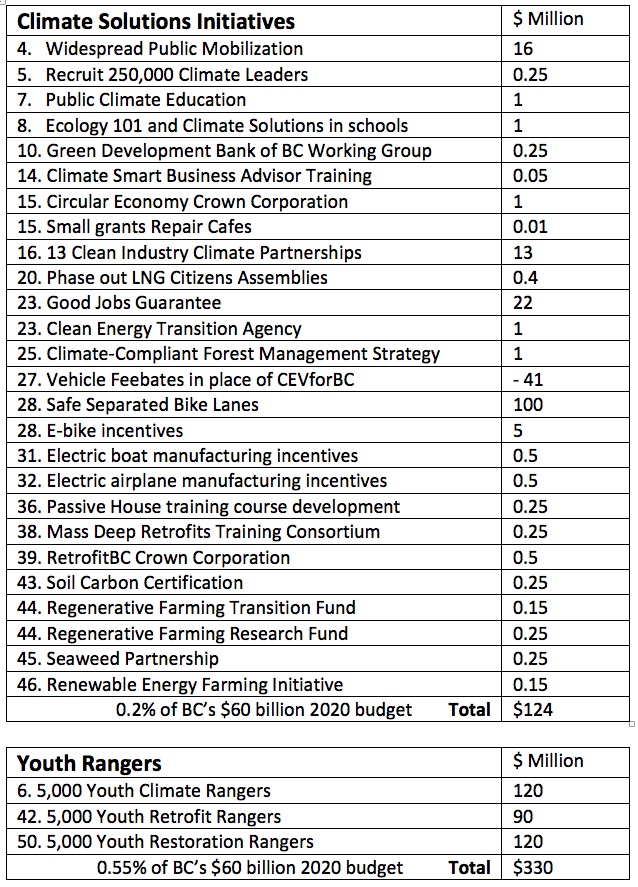
About the Author
 Guy Dauncey is an anthropological economist who works to develop a positive vision of a sustainable future, and to translate that vision into action. He is founder and past-President of the BC Sustainable Energy Association, co-founder of the Victoria Car Share Cooperative, an Honorary Member of the Planning Institute of BC, a Fellow of the Royal Society for the Arts, a Fellow of the Findhorn Foundation, producer and host of Change the World on Spotlight (Shaw TV), President of the Yellow Point Ecological Society, and a member of the GTEC Council for the New Green Economy.
Guy Dauncey is an anthropological economist who works to develop a positive vision of a sustainable future, and to translate that vision into action. He is founder and past-President of the BC Sustainable Energy Association, co-founder of the Victoria Car Share Cooperative, an Honorary Member of the Planning Institute of BC, a Fellow of the Royal Society for the Arts, a Fellow of the Findhorn Foundation, producer and host of Change the World on Spotlight (Shaw TV), President of the Yellow Point Ecological Society, and a member of the GTEC Council for the New Green Economy.
He is the author or co-author of ten books, including:
- Stormy Weather: 101 Solutions to Global Climate Change (2000). Winner of a Nautilus Gold Award. “A fabulous book. Everybody talks about the climate, but nobody does anything about it. Now they can. Stormy Weather provides a sweeping vision of the issues, and comprehensive practical solutions. A must read for anyone who wants a cleaner, healthier planet.” – James Hansen, past-Director, NASA Goddard Institute.
- The Climate Challenge: 101 Solutions to Global Warming (2009). Winner of a Silver Nautilus Award. “Guy Dauncey has created something unique in the current literature by blending a highly readable narrative on global warming, a rich picture book on climate solutions, and an up-to-date digest of the relevant heaps of climate change information that have steadily grown into electronic Himalayas. If you wish to grasp the mind-boggling complexity of the climate challenge, read his book”. – John Shellnhuber, Director Emeritus of the Potsdam Institute for Climate Impact Research, Senior Research Fellow at the Stockholm Resilience Centre.
- Journey to the Future: A Better World Is Possible. “Guy Dauncey has written an imaginative tour de force, blending science, philosophy, and fiction into a delightful story about how we can and must change the world, resulting in a bright green future.” – David R. Boyd, author of The Optimistic Environmentalist.
In January 2020 he published Climate Emergency: A 26-Week Transition Program for Canada. What could the government of Canada do if its Ministers, MPs and civil servants knew that there was very strong public support to address the real severity of the climate emergency, and the urgency of the need? His paper shows how Canada’s federal government could target a 65% reduction in emissions by 2030 and 100% by 2040. It proposed 164 new policies and programs, financed by $59 billion a year in new investments, without raising taxes or increasing public sector borrowing.
A practical, down-to-earth, concrete, step-by-step transition strategy for the Canadian government to get real about the climate emergency. A must-read for all Canadians to make a difference and communicate to their elected officials new policies and programs that will make a difference now.
– Ann Dale, Trudeau Fellow Alumna, Canada Research Chair, Royal Roads University
Vital reading. It should be read by politicians and policymakers, local and regional councillors, business front-runners, university and health service delivery managers, indeed everyone who wants to explore how we can collectively build the new zero carbon world we so urgently need.
– Paul Allen, Project Coordinator, Zero Carbon Britain project, Centre for Alternative Technology
Visionary and thorough, Dauncey’s 26 week Transition Program deserves close scrutiny in Canada and beyond. His passion for a clean economy shines.
– Raffi Cavoukian, C.M., O.B.C., singer, founder of Raffi Foundation For Child Honouring
Guy Dauncey 250-924-1445 guydauncey@earthfuture.com

